1lumen selects and reviews products personally. We may earn affiliate commissions through our links, which help support our testing.
Fenix LR60R review
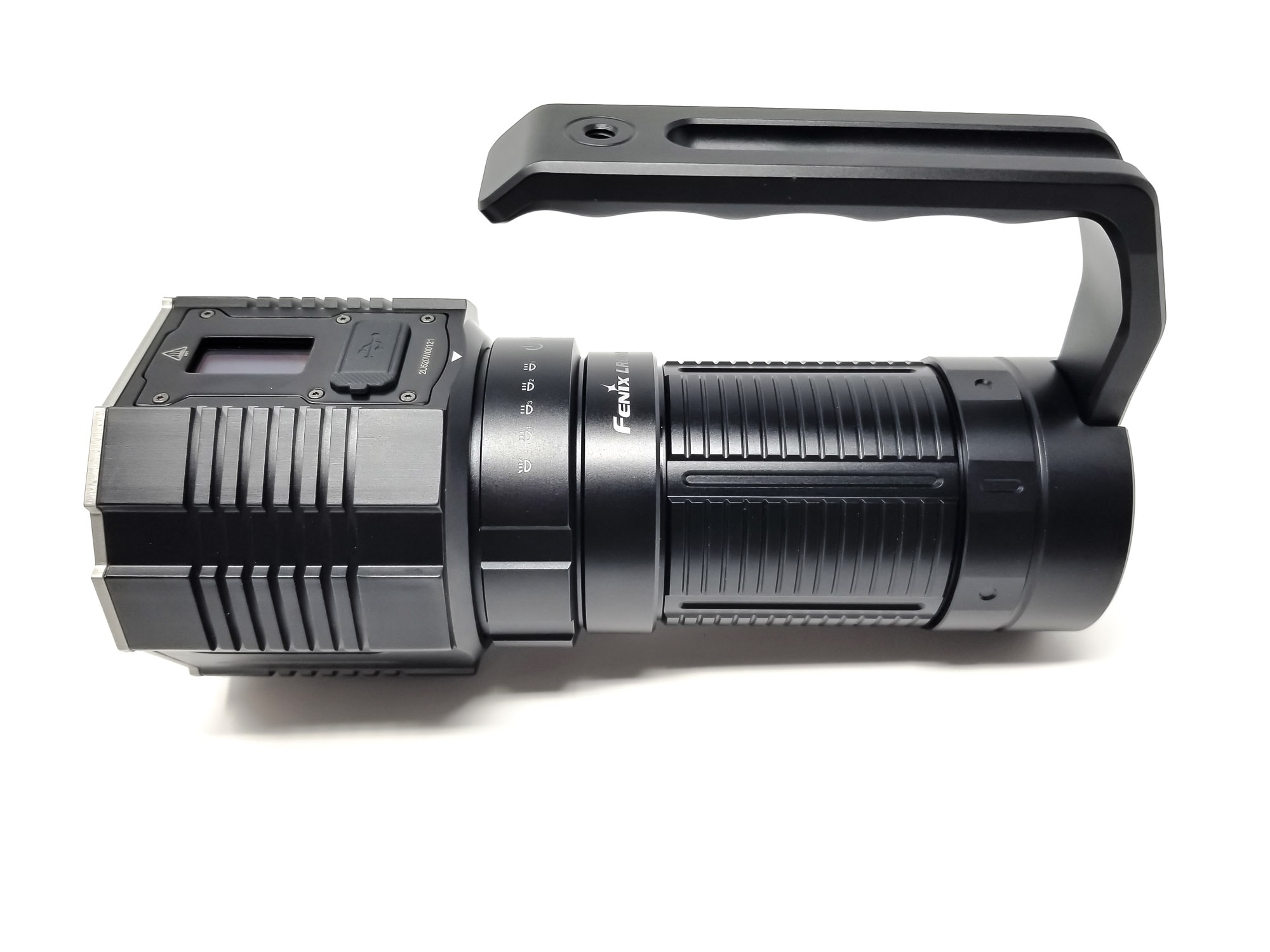
Fenix LR60R specs
| Brand & Model | Fenix LR60R |
|---|---|
| Flashlight category | Searchlight |
| LED | 1*Luminus SFT70 12*Luminus SST40 |
| Max. output | 21,000 lumens |
| Max. beam distance | 1085 meters |
| Max. beam intensity | 294,267 cd |
| Battery config. | 4*21700 battery pack |
| Onboard charging | USB type C |
| Main modes | 5 |
| Blinkies | Strobe, SOS |
| Waterproof | IP68 |
| Review publication date | December 2023 |
Review intro:
Fenix is a familiar face here at 1Lumen. They’re truly a global company and have carved out a nice bit of real estate in the flashlight market and lots of flashlight enthusiasts and everyday folks alike look to Fenix for high quality, high performance portable lighting products. I’ve reviewed a bunch of Fenix products, from the flagship LR80R searchlight, the flagship HP30R V2 headlamp, and tiny keychain lights like the E03R V2.
Today, I won’t be looking at a keychain light, but I will be looking at something brand-new from Fenix. First though a bit of backstory (dim the lights please). This light goes way back a couple years from inception to completion and represents a new venture for the brand and implements an existing technology somewhere it hadn’t been before.
In fact, this new light was so revolutionary, it won the 2023 Red Dot Product Design award, which is a pretty big deal and a sought-after distinction. The new light is the Fenix LR60R, which was rolled out earlier in 2023. While it is a high output searchlight, I don’t think Fenix introduced it to replace the LR80R, but it sure does augment it. How revolutionary is the LR60R? Well, it takes design cues from other Fenix lights (and the competition) and melds them into a pretty amazing flashlight with a truly unique and functionally-sound design. How amazing? Let’s see.
Package quality.
The LR60R comes in an identical package to the LR80R. The sturdy box has feature blurbs and graphics all over it, and lifting off the lid reveals the flashlight sitting between two foam holders with the accessories hanging ten. Here’s what’s inside:
- Fenix LR60R
- USB type C charging cable
- Lanyard
- Fenix ARB-L56-4000 battery pack
- Shoulder strap
- Spare o-ring
- Threaded stud with swivel bail
- User manual
- Warranty card
Normally for these lights I’d say this is a complete, ready-to-go kit, but it’s missing an item: A charger. This is a $400+ flashlight and it doesn’t include a wall charger? C’mon Fenix. I’d expect that from someone like Astrolux or Sofirn. I know you can get one for like $20 from China, but if I’m paying this much for a flashlight, I shouldn’t have to. Alas, minus the charger, this is a complete kit and everything needed to get going.
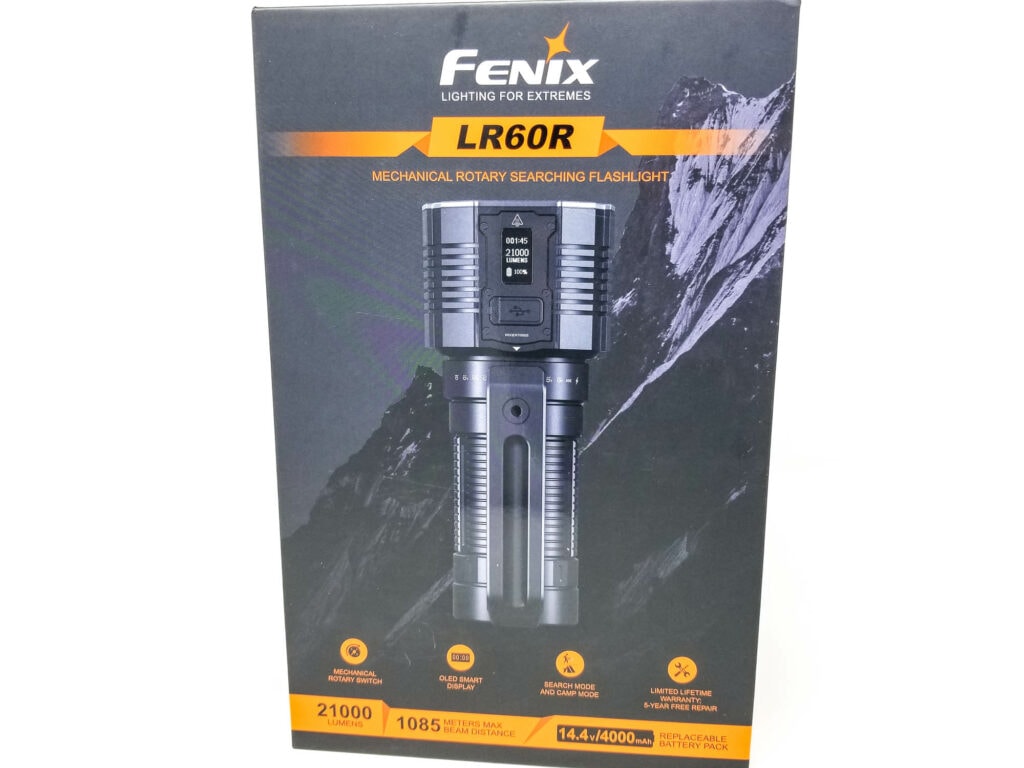
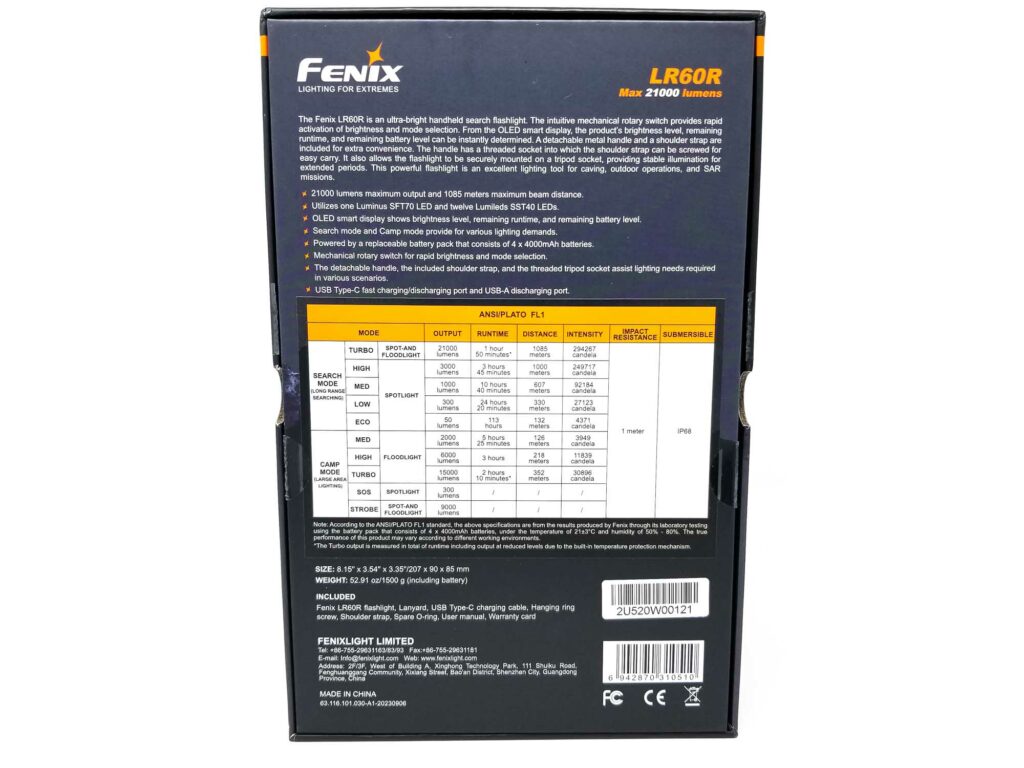
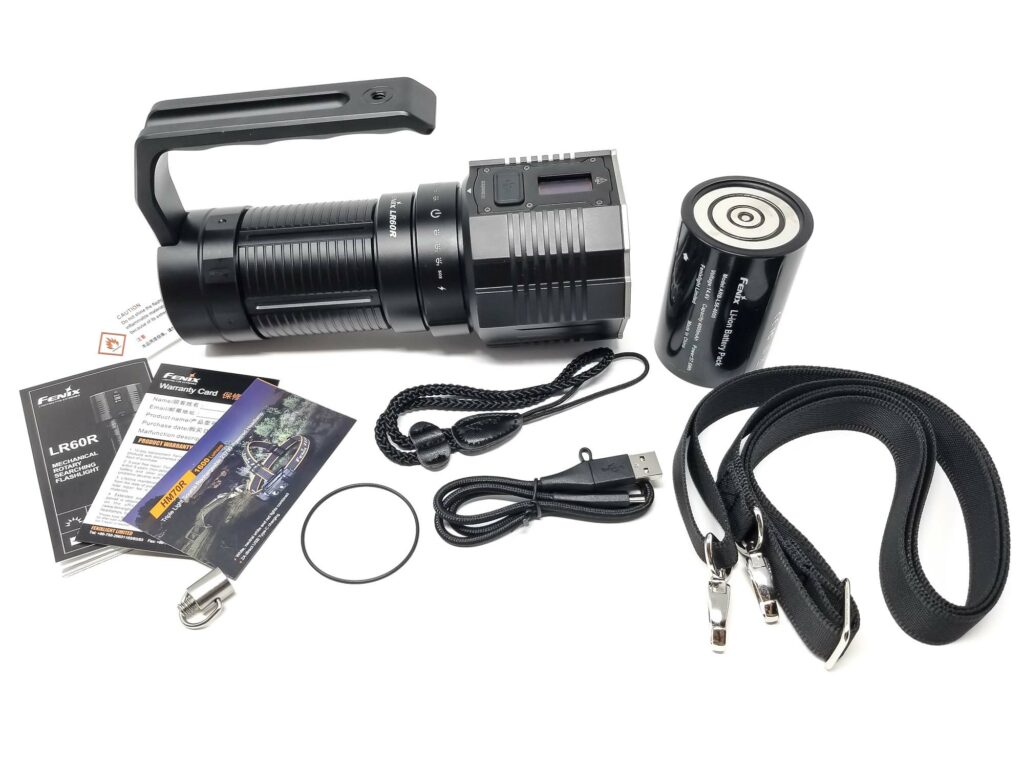
Flashlight in use, Build Quality, and Warranty
The LR60R is part of Fenix’s LR model line of high output searchlight-type flashlights. They typically have multiple batteries and multiple LEDS. Searchlights are big, heavy, and produce many thousands of Lumens often with 1000 meters of beam distance. The LR60R fits this well. It’s over 3 lbs of flashlight and really needs a handle and/or a shoulder harness for carry. It has a removable carry handle secured to the tailcap by two 3 mm hex head screws.
Unlike the LR80R, the handle is fixed in the 12 o’clock position on the removable tailcap, and is positioned with the handle pointing forward, rather than backwards. Fenix must have been intentional in their design for the handle because after handling the LR60R some, I noticed the handle design helps with balance, pointing, and reduced hand fatigue. It also makes manipulating the rotary switch easier since if the handle was affixed to the head, it would be in the way.
The body is huge and wide. I have big hands and I can’t fit them around the handle, but even so, it’s covered with grippy grooves and ridges for a super secure handhold. The head design is very ambitious, featuring a triangle-like shape with 3 symmetrical flat sides with each side having some decent heatsinking fins. There’s a ¼-20 UNC threaded on the underside of the head at roughly the 7 o’clock position for mounting to a tripod, or you can thread in the included mounting stud with bail for attaching the shoulder strap or lanyard.
There’s lanyard mounting points on the tailcap as well. The top side has the USB I/O panel for charging and the power bank output, and a small monochrome OLED display. It shows the Fenix logo when turned on (nice touch) and when the light is on shows battery level, remaining runtime in HH:MM, brightness level. and displays the status for charging/discharging (when using the bidirectional charging). The display is easy to read even in bright light and has good contract for a monochrome display and no issues with viewing angles. The feature Fenix is pushing with this light besides the design, is the switch.
The LR60R represents a leap forward for Fenix since this light doesn’t have switch buttons. Switching is handled by a rotary switch like the PD40R I reviewed, and this one follows the same design, albeit with some grooves cut into the bottom to aid in gripping and turning the switch ring. They’re deep and wide, and made turning the switch easy. The action is well-weighted, with enough resistance to keep it from unintentionally turning, but not enough to make it difficult. There’s detented stops for each mode on the switch, and each locks the switch in position solidly. Overall, it’s a well-executed design that works great. The flat sides along with the handle keep it stable on an incline, and the wide flat tail makes tail stands rock-solid.
For the build quality, it’s typical Fenix all-around, so you get solid build quality, excellent attention to detail, and fantastic fit and finish. The LR60R is most decidedly not a budget light, but it’s not meant to be since searchlights are normally pretty expensive. The MSRP sits around $420, and for what you get, that’s a fair price for this light. If you need this level of capability and quality, you’ll gladly shell out the dough for it. In keeping with the price and mission, I can report zero issues with build quality, errant part fit-up, and no concern with the quality.
The host is milled fro high quality 6061-T6 aluminum and the finish is type III HA hard anodizing. Once again, it’s any color you want as long as it’s black, and it’s the same semi-gloss finish I’ve come to expect from Fenix. It’s not my favorite, and I think it could benefit from a more matte finish with better tack and grip like Acebeam’s finish. Like I expect from a ‘working’ light, there’s springs for all battery contacts: Three gold-plated coil springs at the tail for the negative contacts and a network of spring-loaded pogo contacts at the driver that interface with circular contact rings on the battery pack.
These work to protect the battery and driver from shock loading and ensure constant pressure on the contacts to prevent connection breaks. The tailcap threads are thick square cut units, fully anodized, and super smooth. There’s minimal lube on them, and it’s sealed with an o-ring. The I/O for the charging/powerbank are sealed with a nice rubber flap. It has indexing protrusions on the backside to seal the openings for the charge ports for extra sealing.Fenix sticks the LR60R with an impressive IP68 rating.
Warranty? Fenix has a great one! From Fenix:15 days free replacement: Fenix will replace a new product within 15 days of purchase for any manufacturing defects if problems come into being in normal use; We will replace it with the same model. If the model has been discontinued, customers will receive a product with similar or improved model.5 years free repairs: Fenix will offer free repair within 5 years for lights from the date of purchase if problem develops with normal use. Different warranty period for different products:
• Flashlight, Headlamp, Bike Light and Camping Lantern (without a built-in battery) – 5 years (excludes rechargeable battery)
• Flashlight, Headlamp, Bike Light and Camping Lantern (with a built-in battery) – 2 years (battery included)
• Rechargeable battery, battery charger, bike mount, remote pressure switch – 1 year
Except the products and accessories listed above, other products or free offers provided by Fenix are not covered within the product’s warranty. Limited Lifetime Warranty: For lights past the free repair warranty period, we provide lifetime repairs but will charge for parts. Fenix Lighting LLC will notify customer the cost of the part before repair. Please note, due to changing technology, not all older lights will be able to be repaired due to parts not being available. In such cases, Fenix Lighting LLC may provide a discount to the customer for the purchase of a newer model.
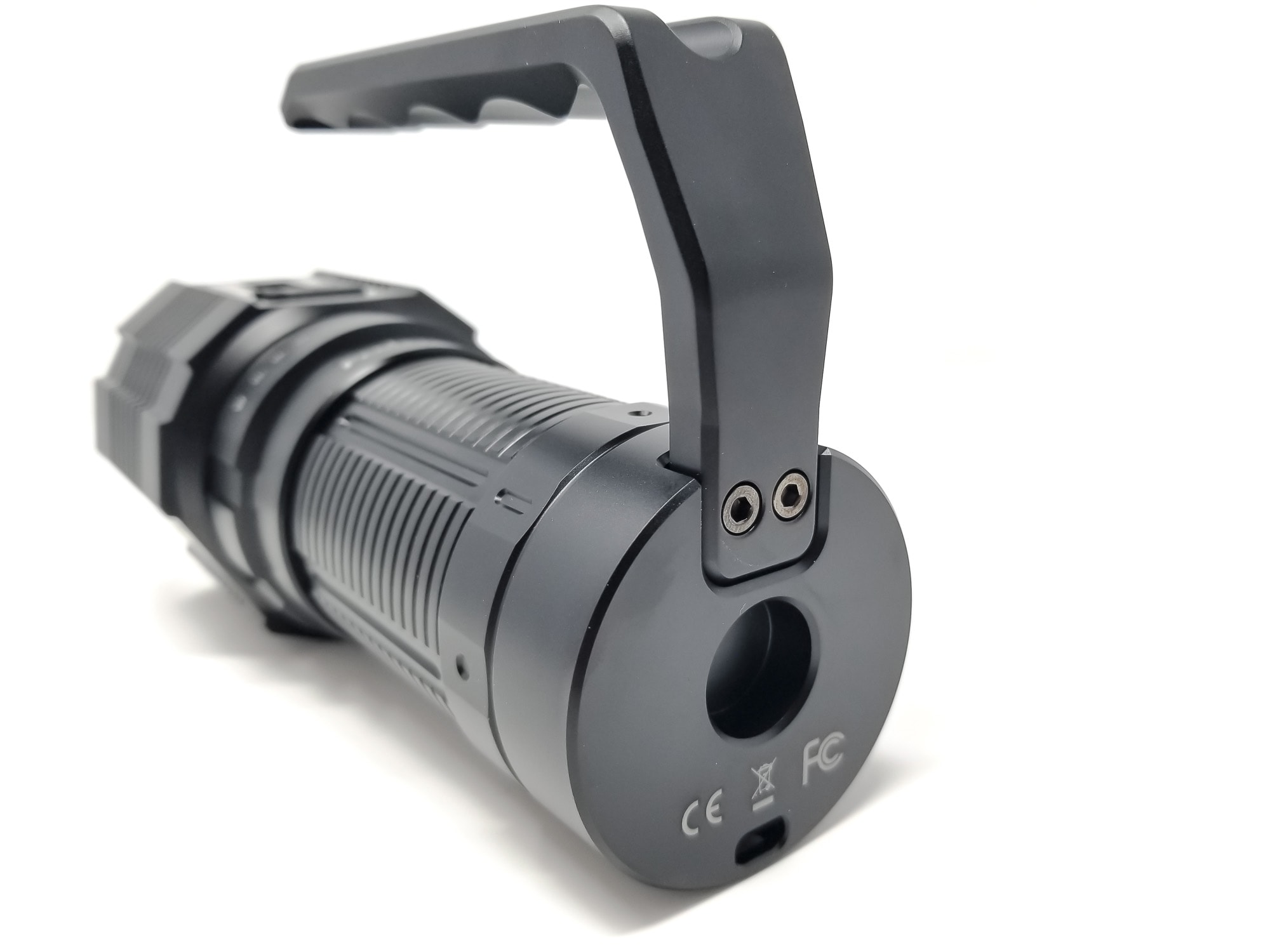
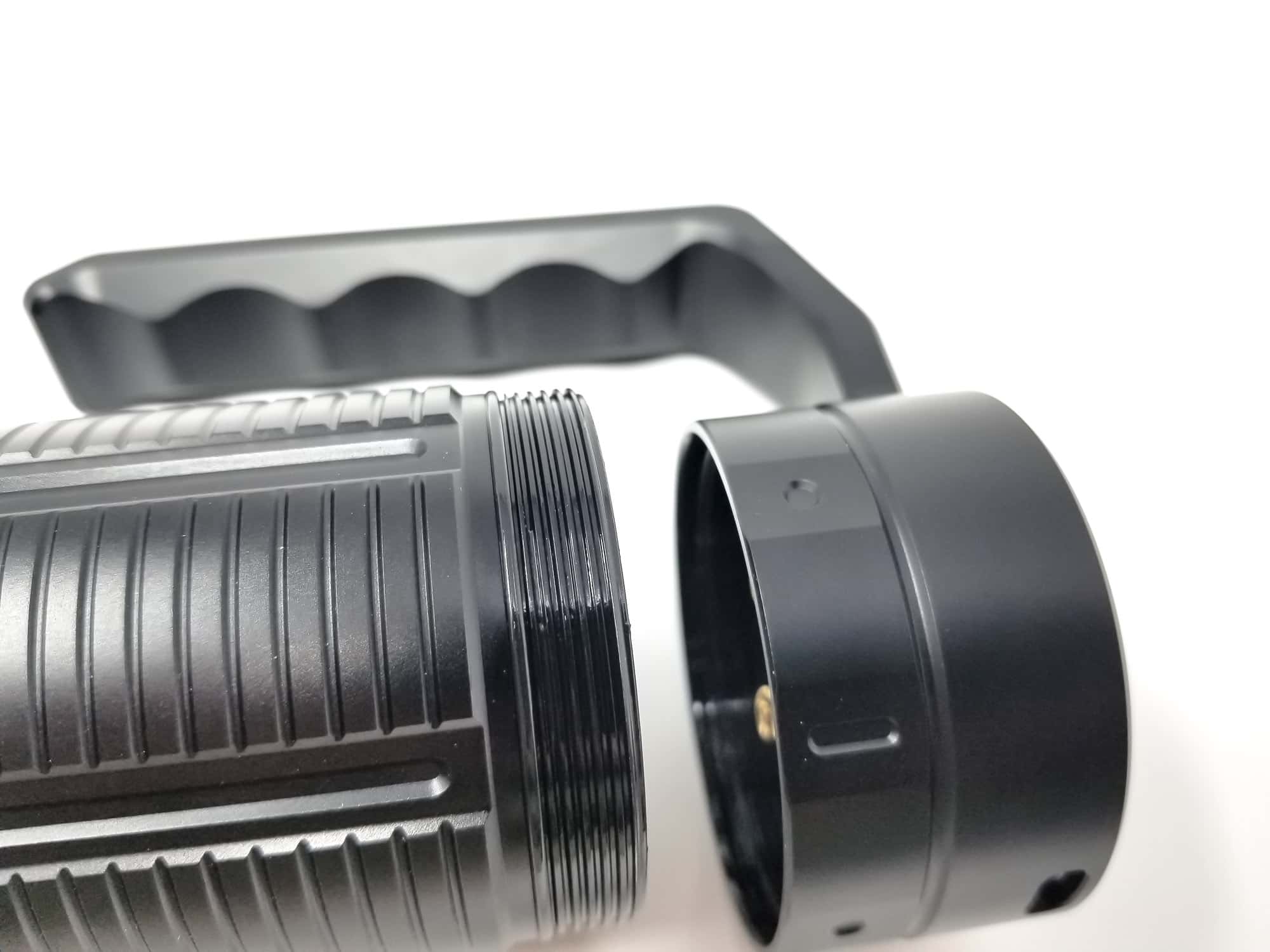
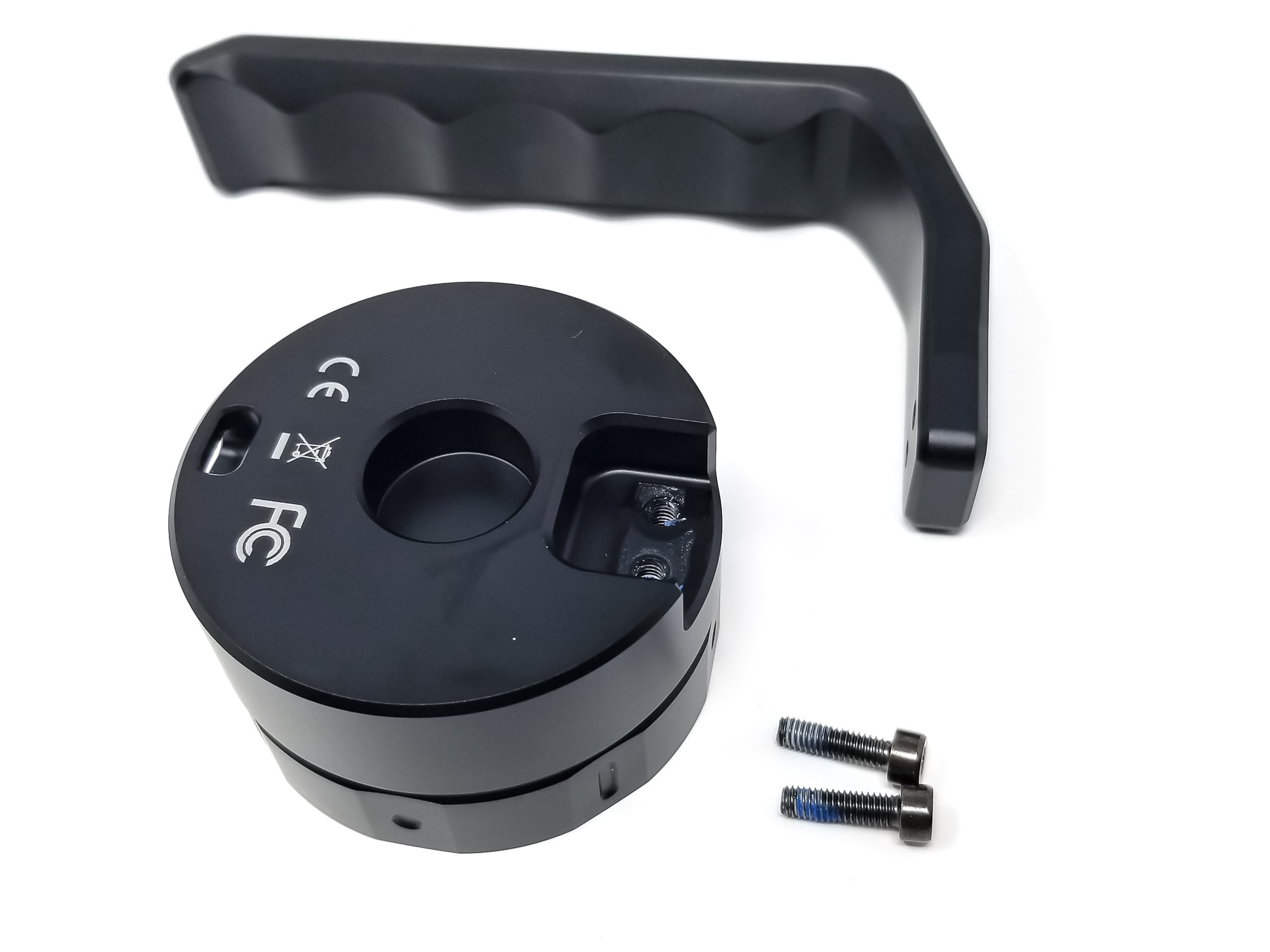
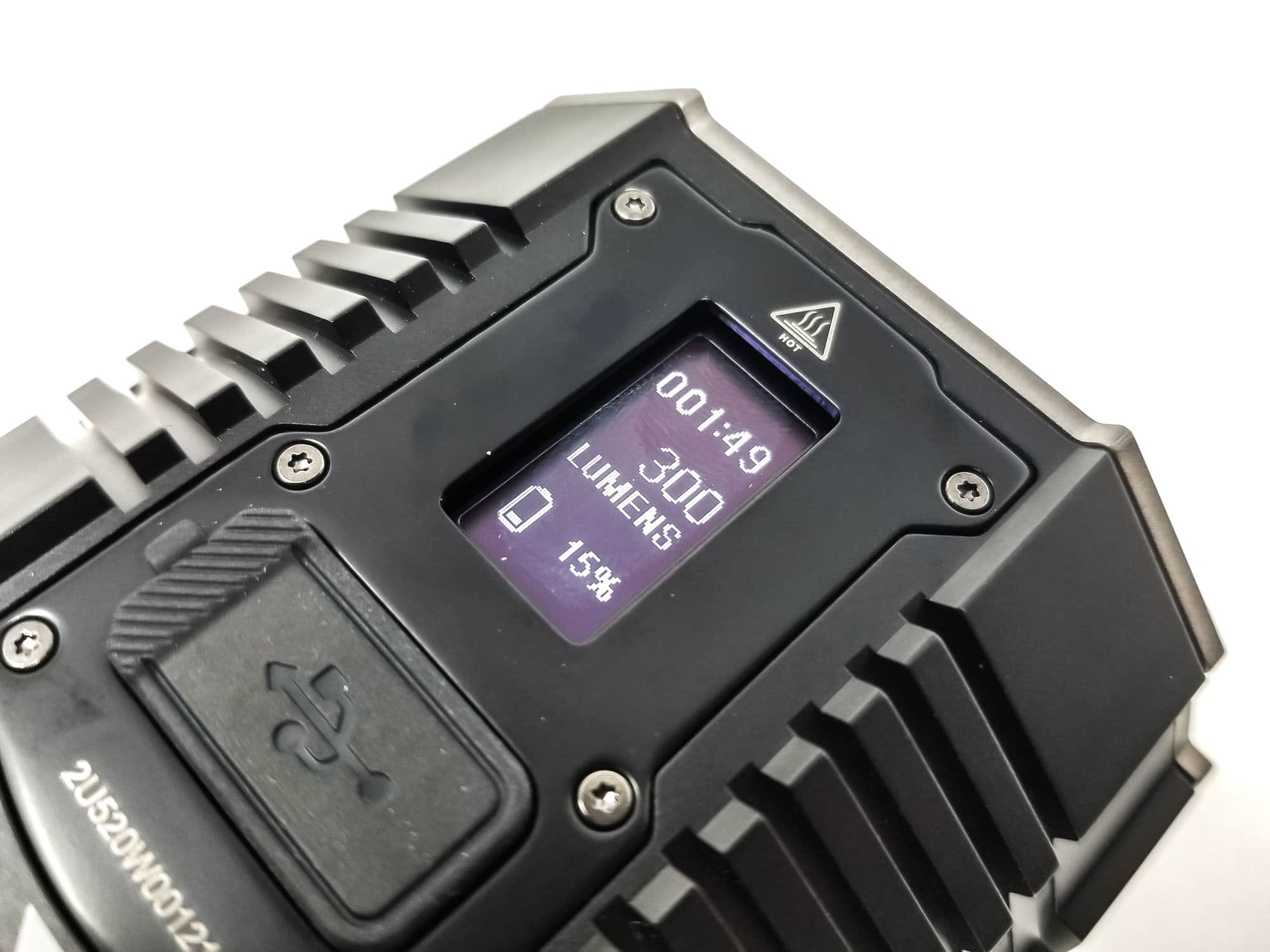
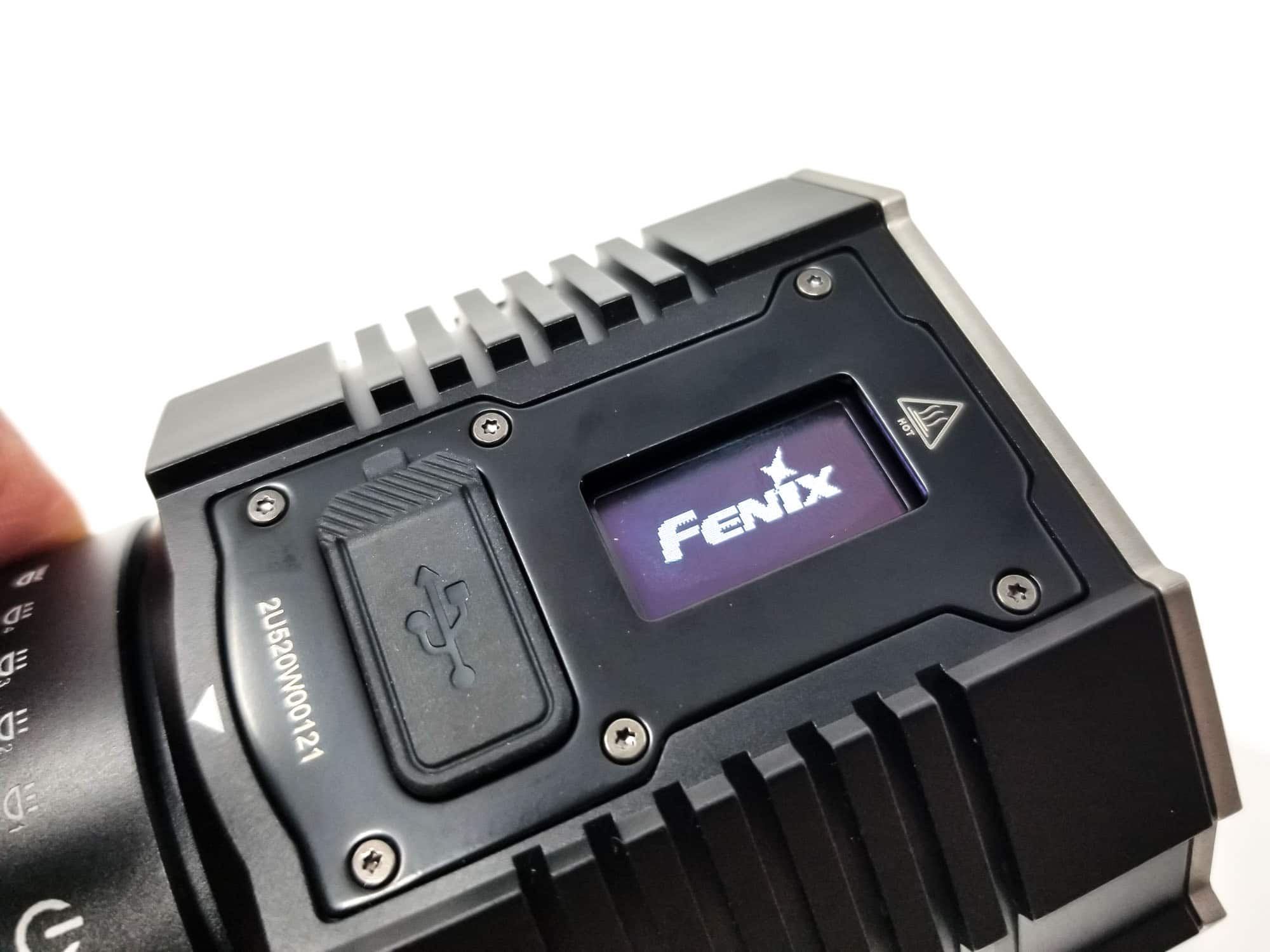
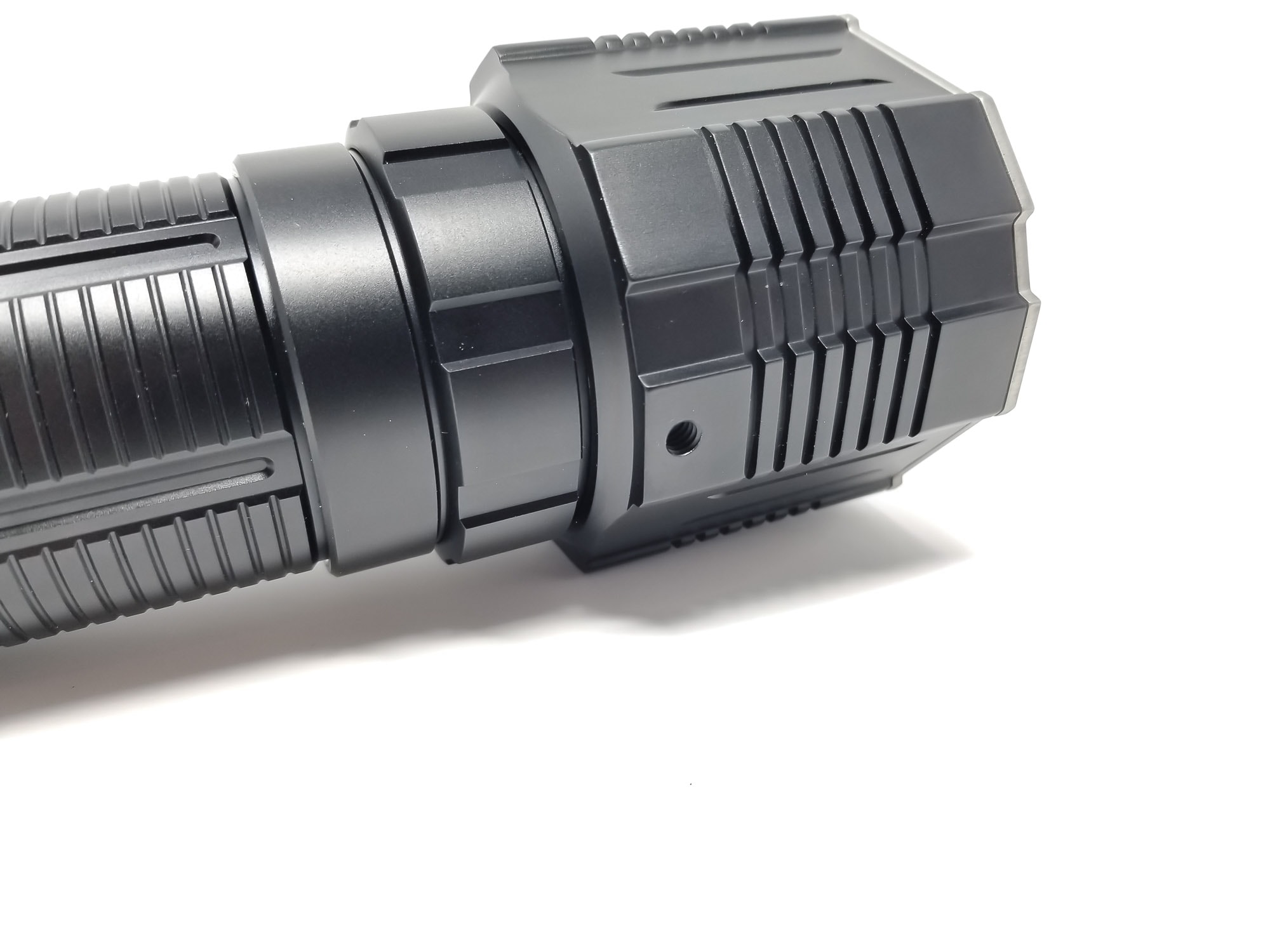
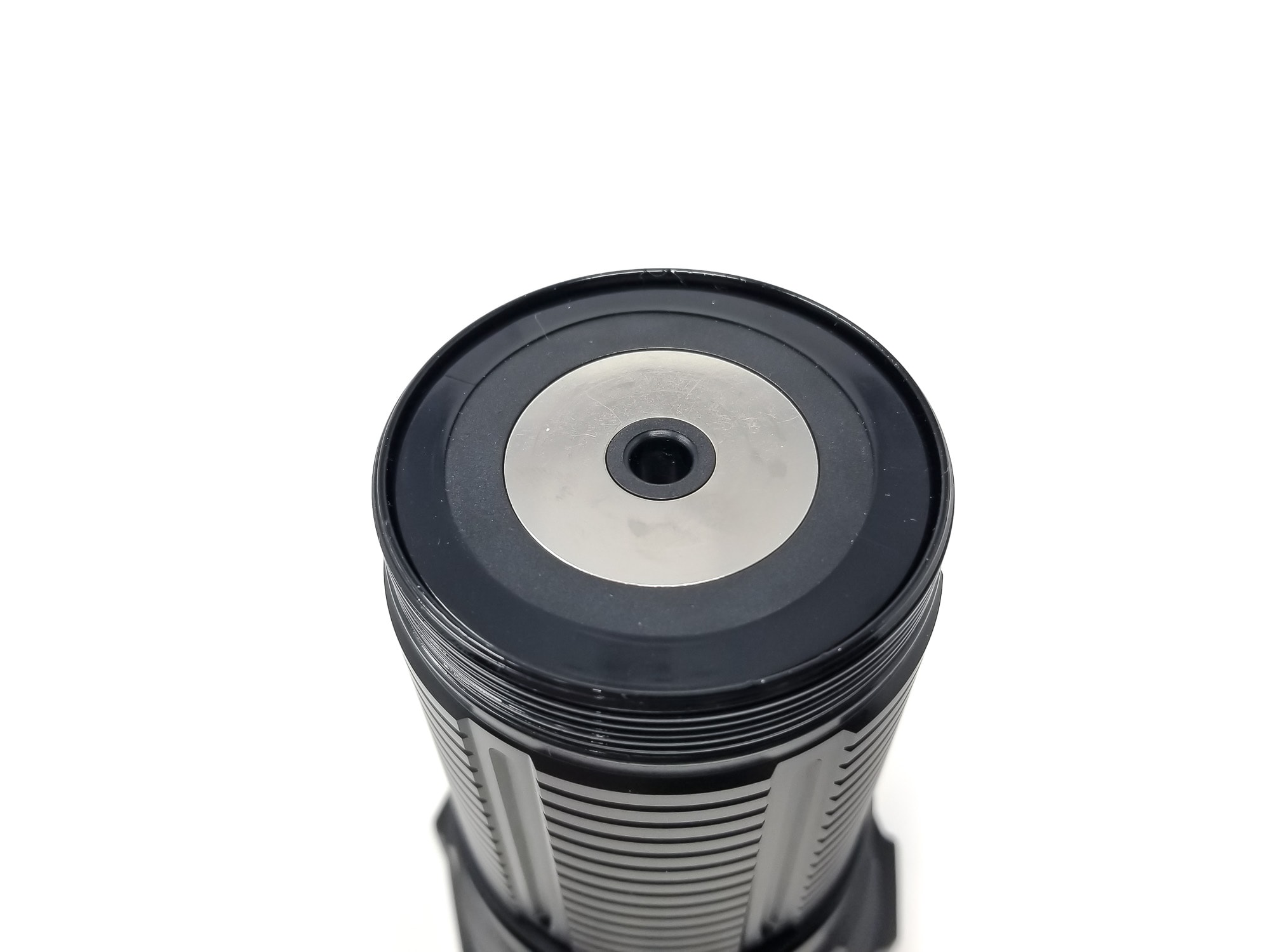
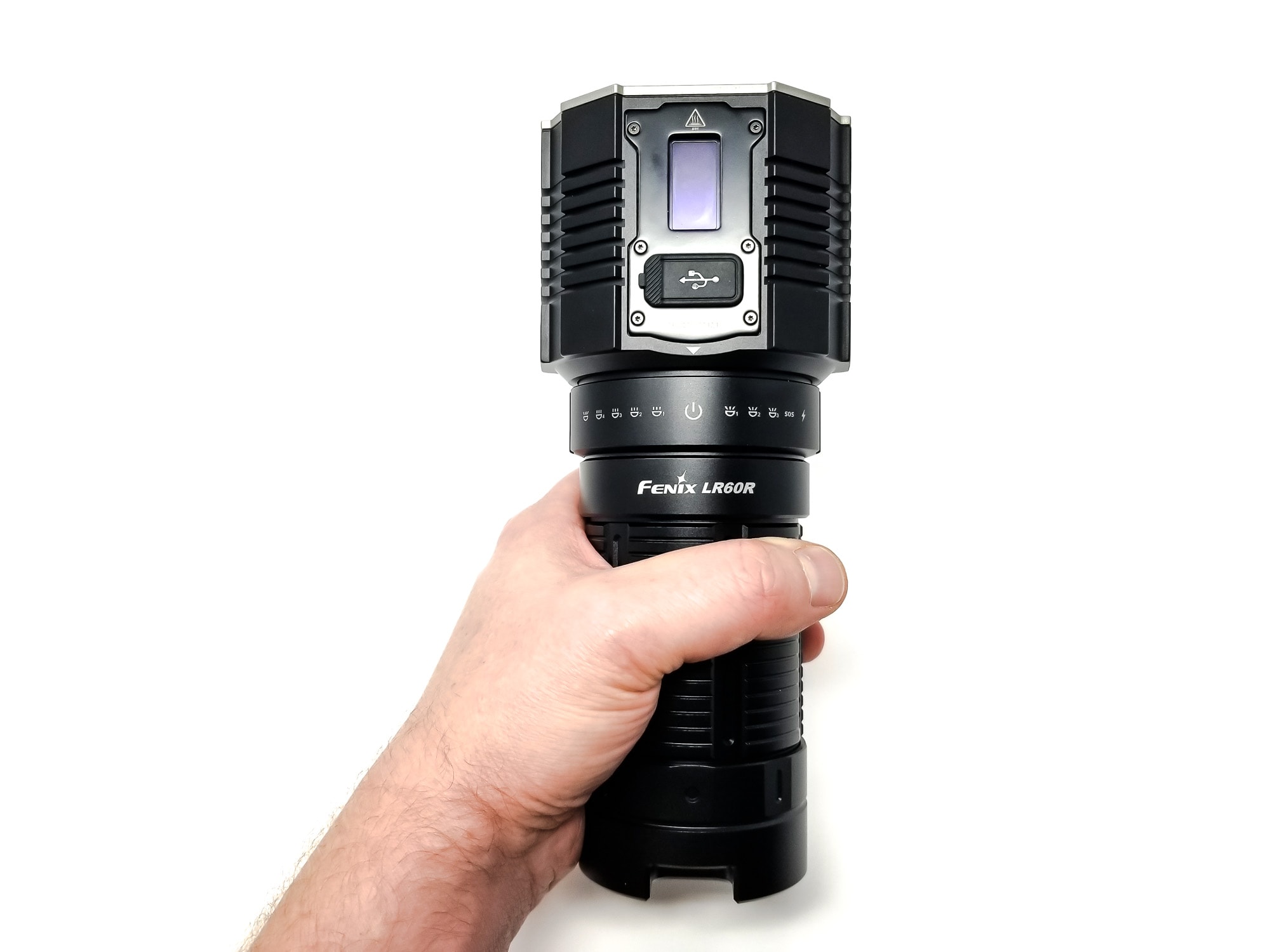
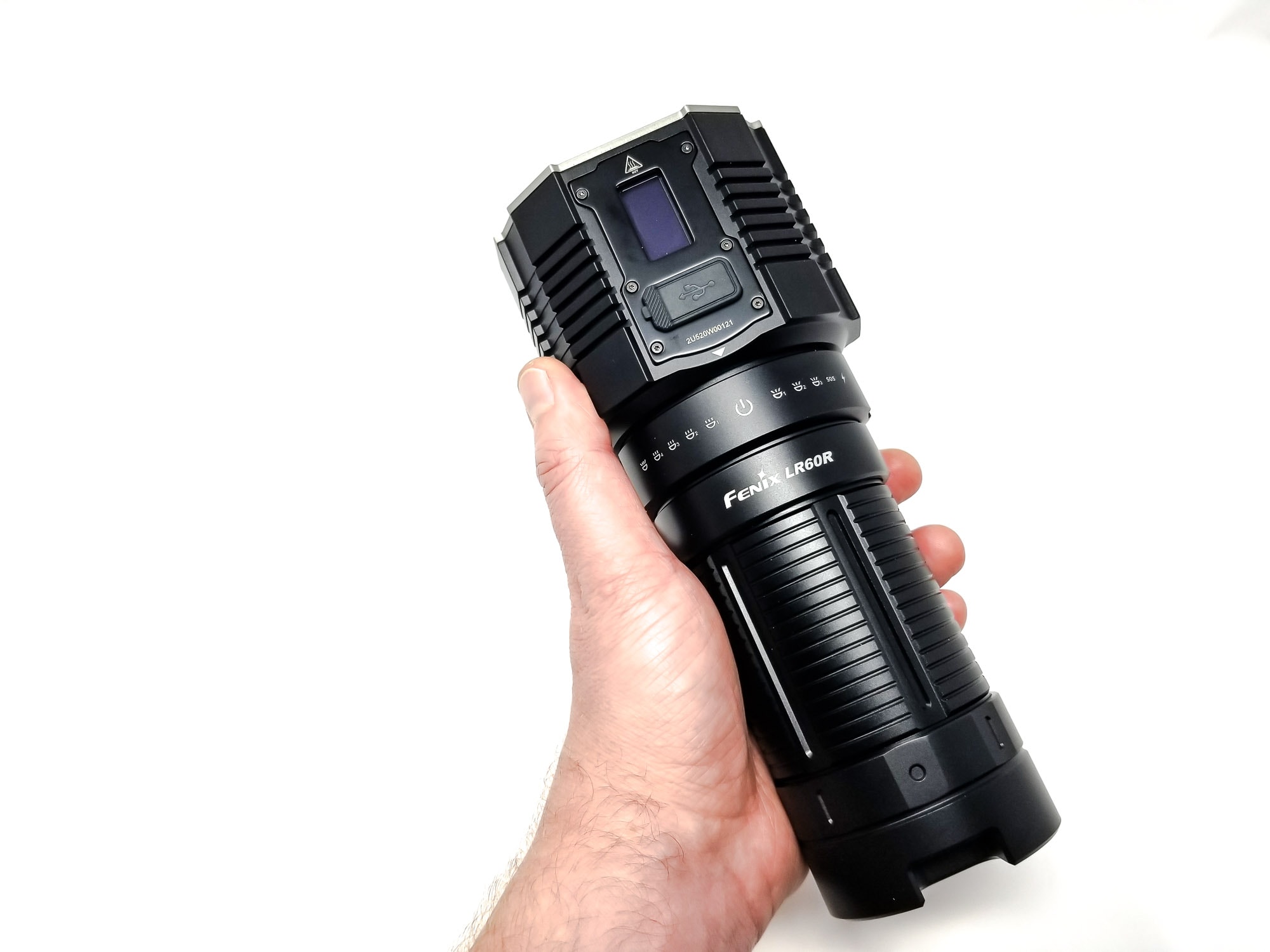
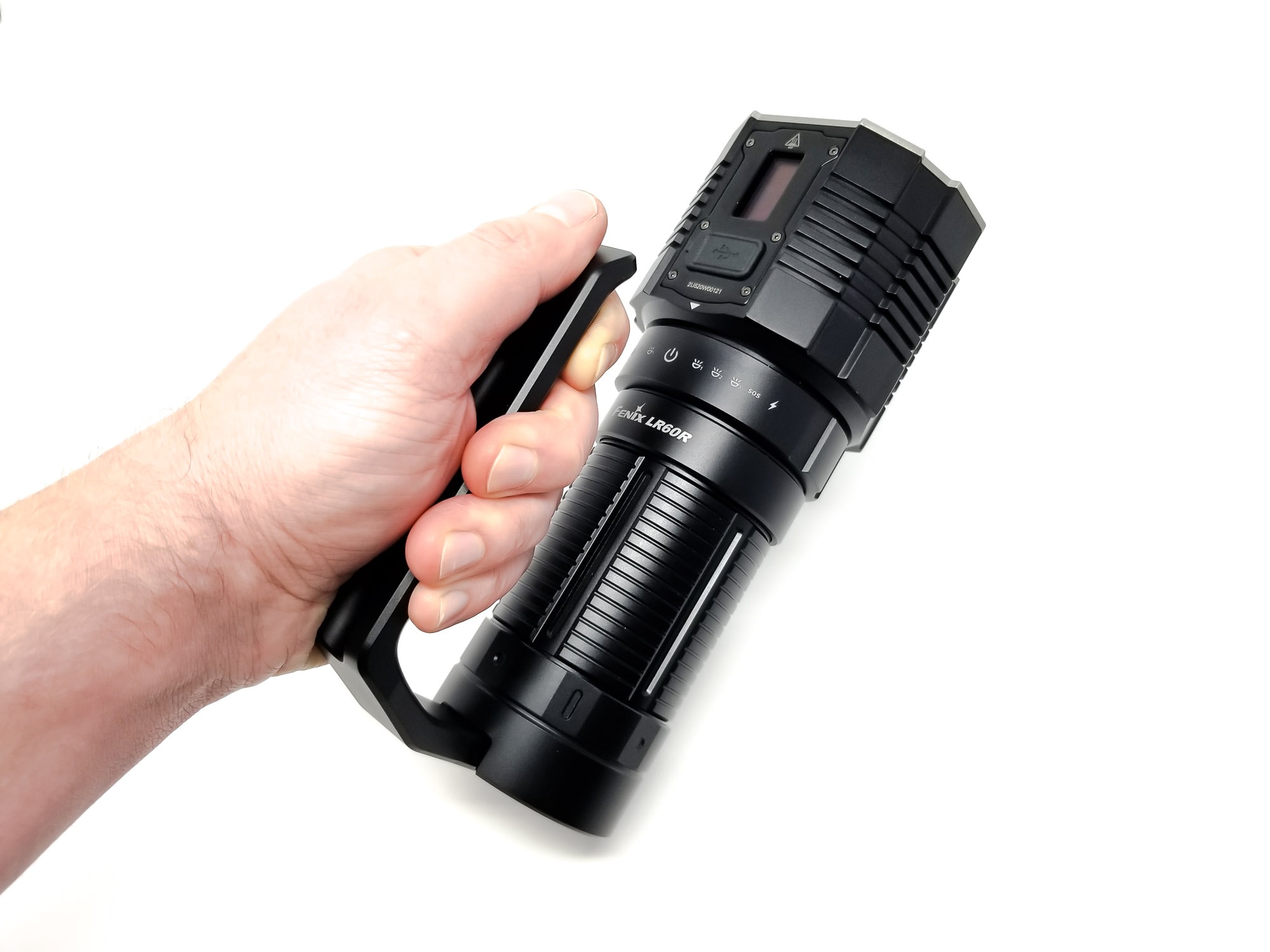
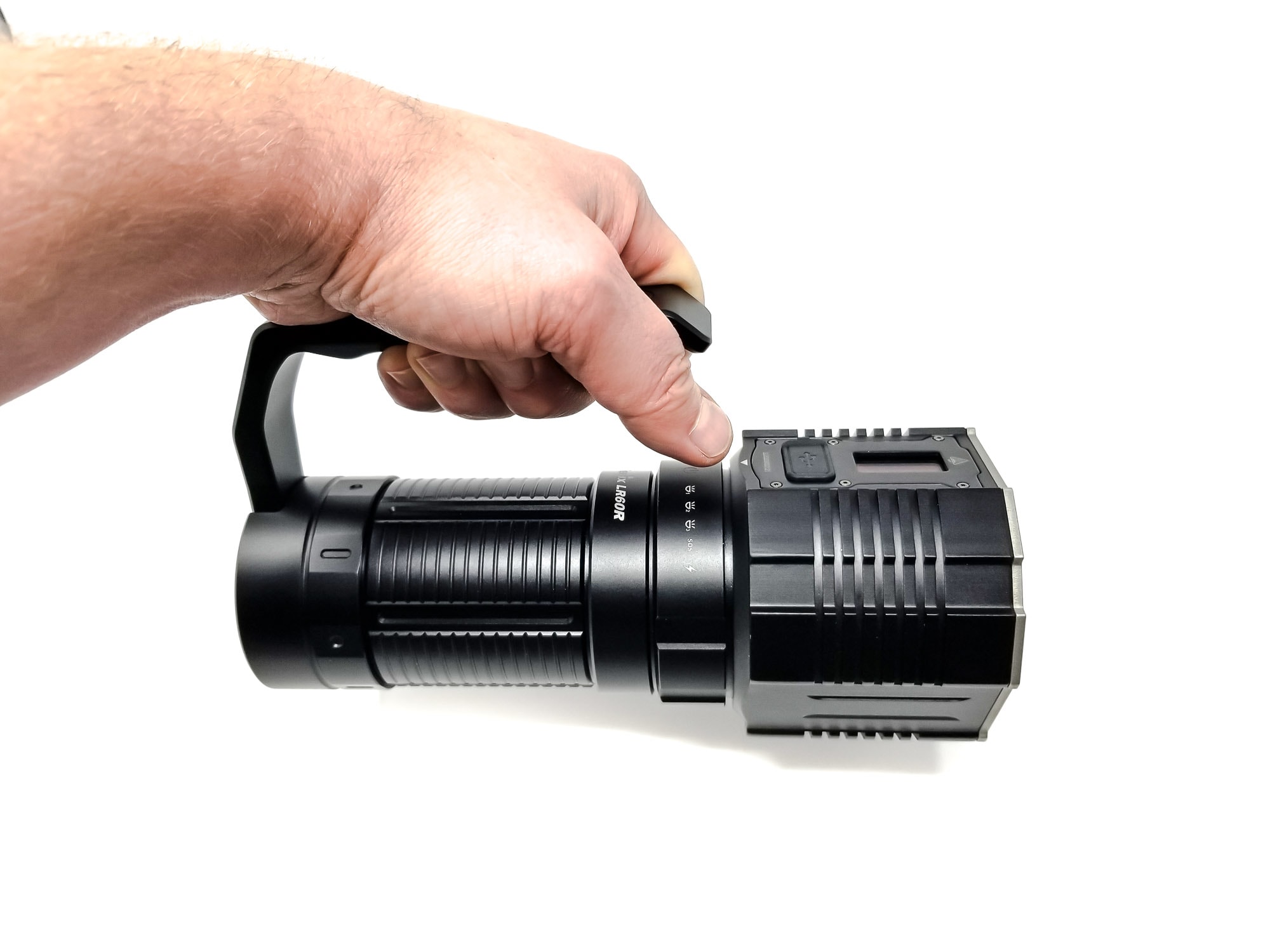
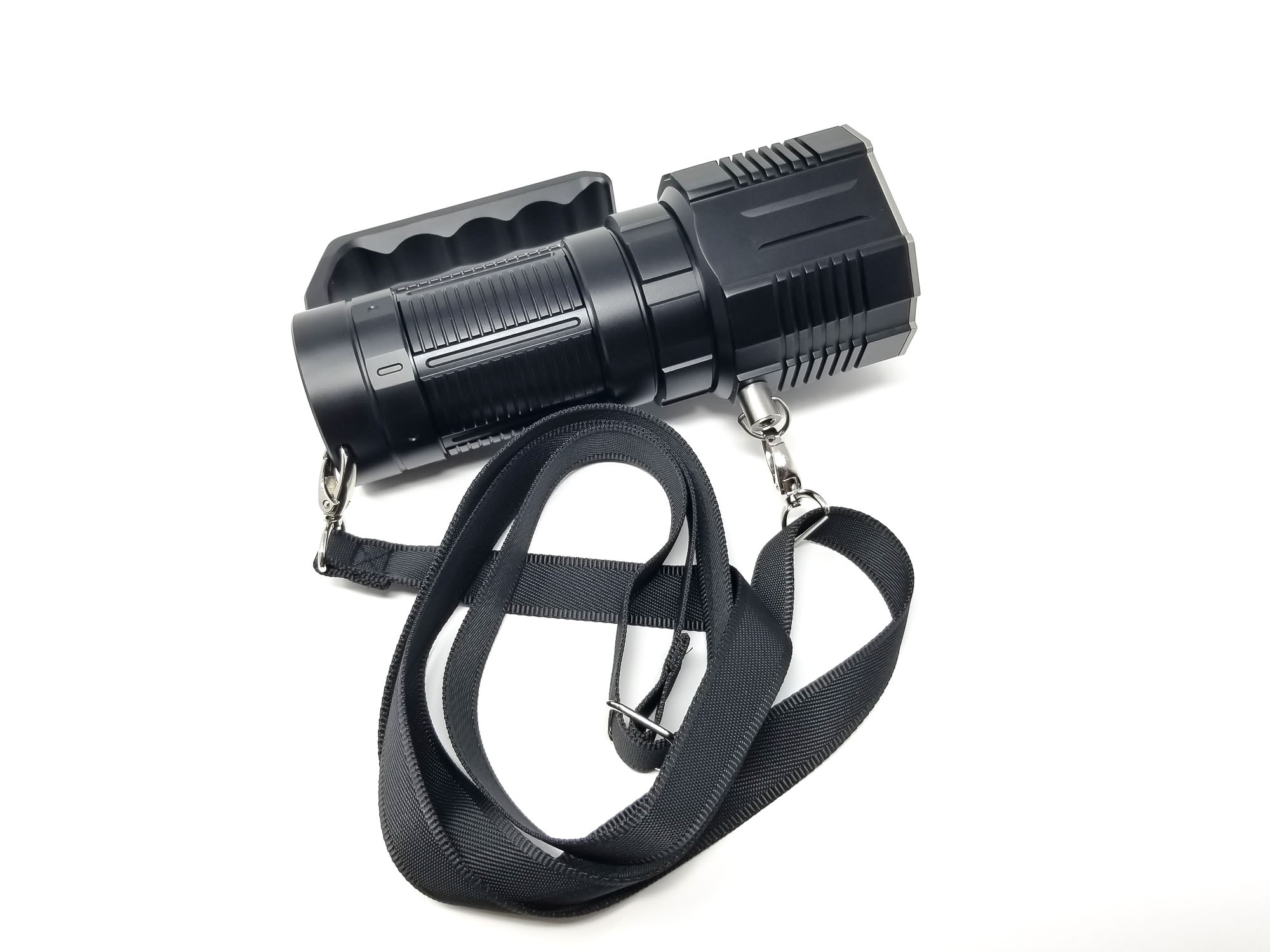
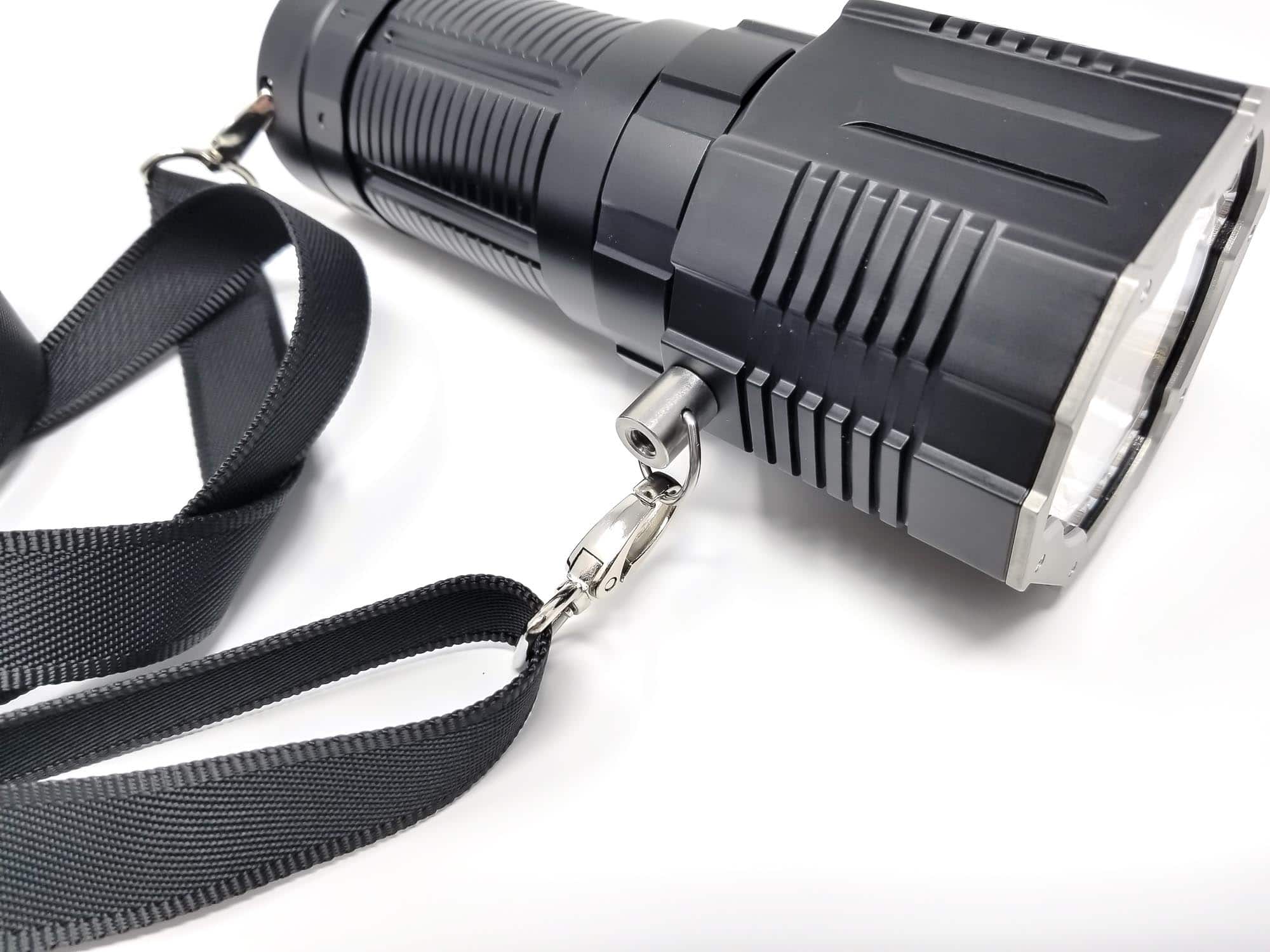
LED, Lens, Bezel, Beam, and Reflector
The LR series have always been multi-LED lights and whereas the LR80R used only a single type of LED, the LR60R uses two. Total, there’s 15 LEDs. For the floodlight functionality, they’ve enlisted the OG 5050 size high performance LED that’s been in a ton of lights over the last 5 years, the Luminus SST40. It’s still used in some Fenix products, and it’s a good fit here. While it’s been largely usurped by the SFT-40-W, the SST40 produces a lot of light at relatively low drive currents thanks to the low thermal resistance and low vF.
You get 12 SST40s arranged in 3 sets of 4 LEDs on each corner of the head, each having its own small SMO reflector. Major props to Fenix for this adventurous design, and I bet focusing these took a ton of R&D and testing. The spotlight function uses a single LED, and they’ve chosen a high output, high intensity LED that isn’t the SBT90.2. I’m talking about the Luminus SFT70, their 5050-size quad die high intensity LED. It’s been around for a couple years, and is already featured in a lot of flashlights. With 4 dies connected in series/parallel for 6 or 12 volts, this LED has high output and great beam distance, even in smaller reflectors.
The SFT70 is mounted in a large, deep SMO reflector with a roughly ¾ inch band of texturing around the base of the cup. I think this is to smooth the edges of the hotspot a bit and minimize errant reflections in the beam. Whatever it is, it works, since the beam is very nicely focused and doesn’t have any weird rings or aberrations. On the floodlight channel, you get a massive wall of light: I mean, it’s super-impressive and lights up everything in a 180 degree arc. The spotlight is exactly that…a thrower beam with a focused hotspot and bright spill. Combined, the spot/flood beam is a thing of beauty: The wide flood combines perfectly with the spotlight for amazing coverage and reach. Tint for these LEDs is definitely cool white, which is totally fine for this application.
Spectral measurements:
I used the Opple Lightmaster Pro to measure the flashlight at 1 meter from the sensor.
| Mode: | CCT: | CRI Ra: | duv |
|---|---|---|---|
| Floodlight Turbo | 5947 | 64.4 | 0.0079 |
| Spotlight High | 6629 | 68.5 | 0.0062 |
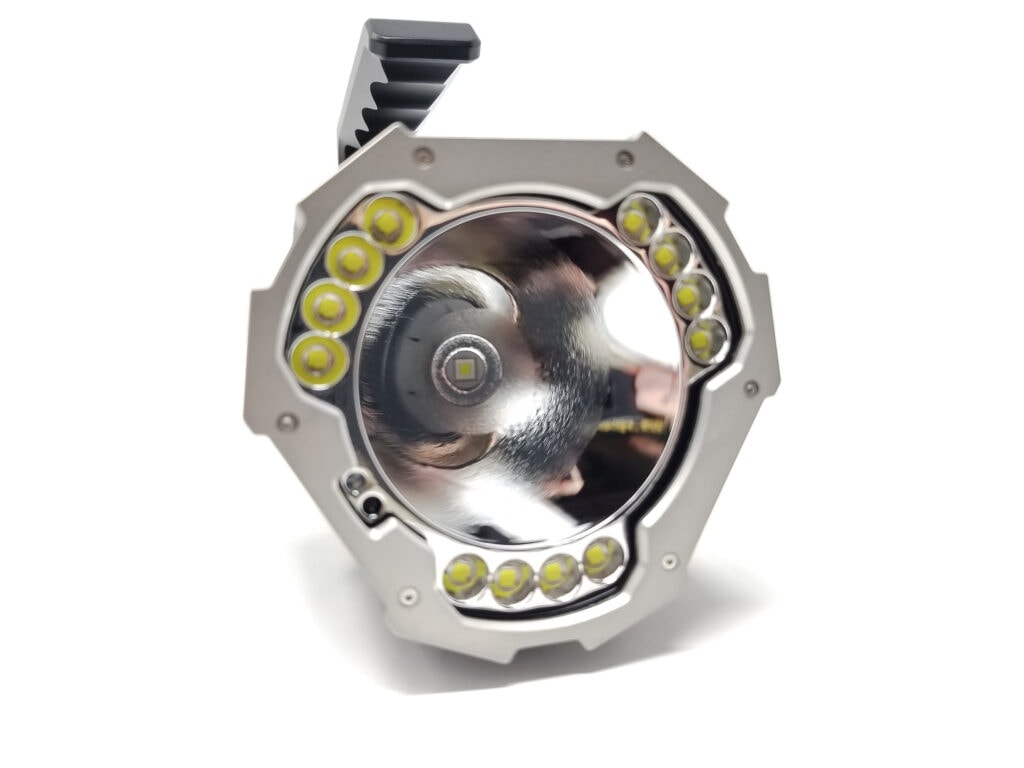
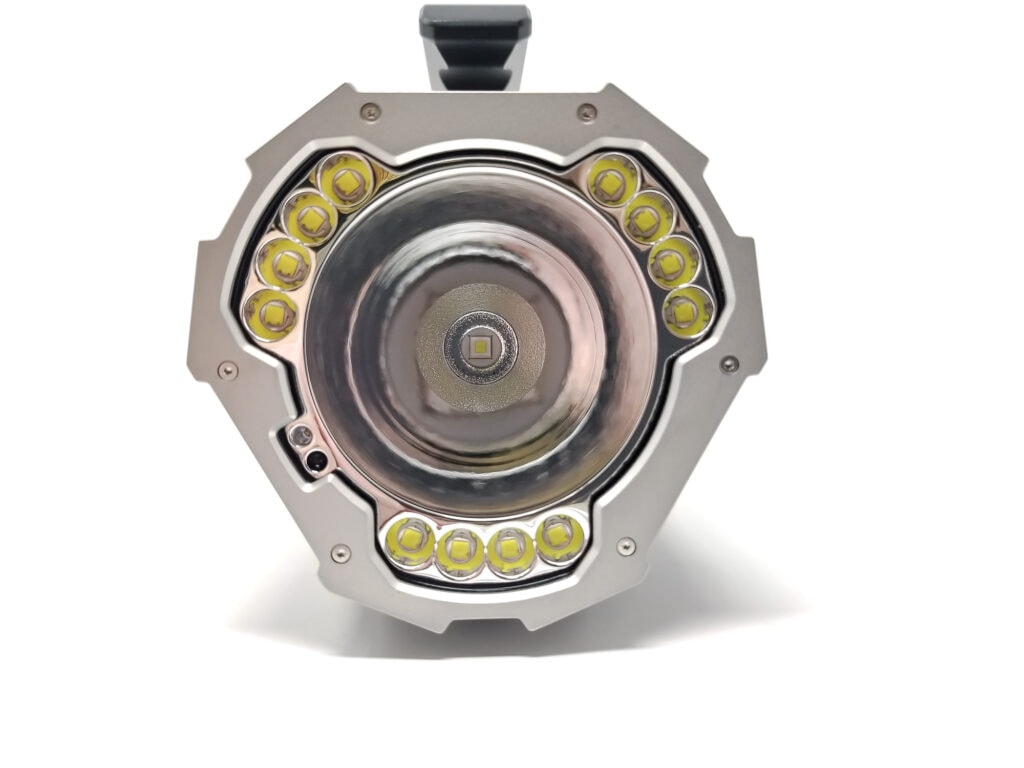
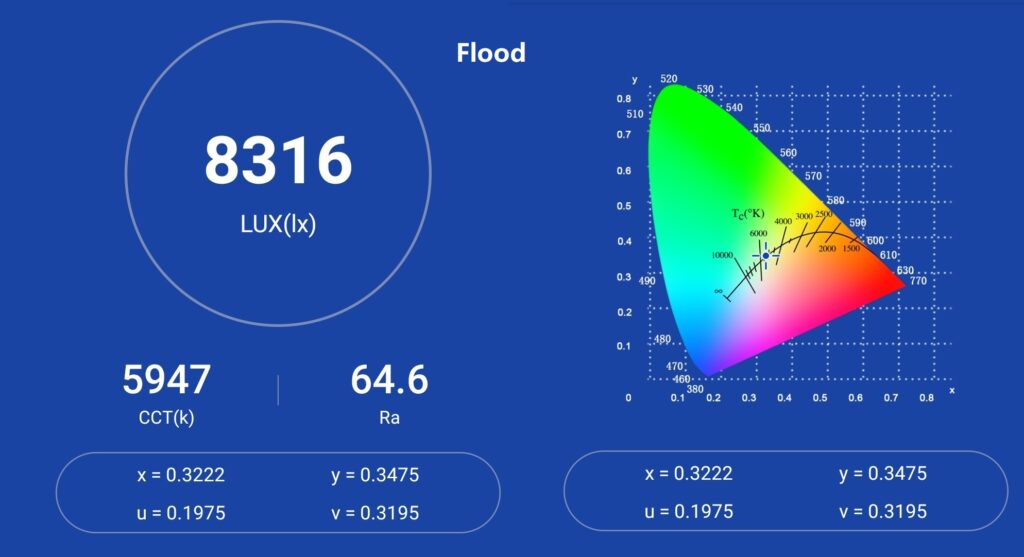
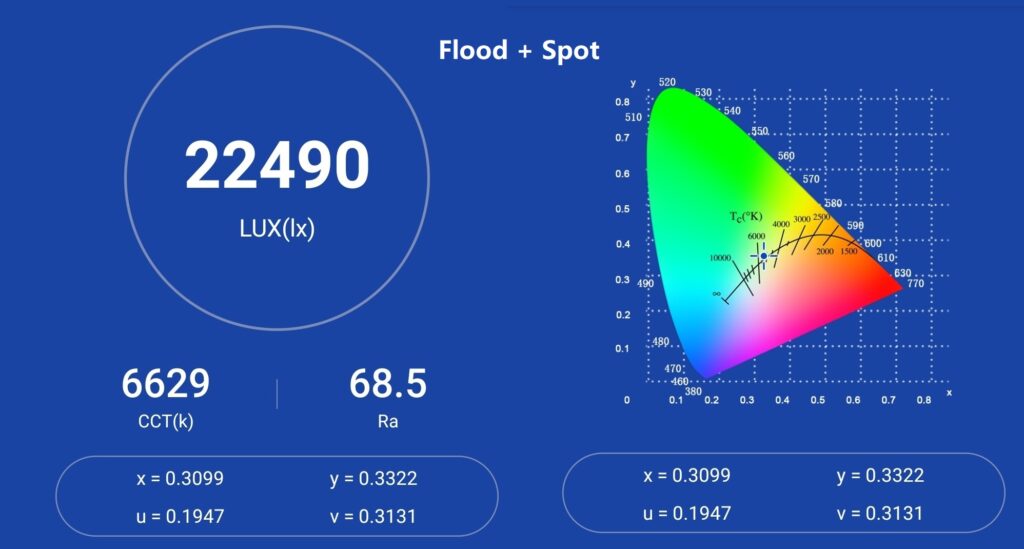
Dimensions and its competition
Dimensions:
| Fenix LR60R | Millimeters | Inches |
|---|---|---|
| Length | 207 mm | 8.1 in |
| Head diameter | 90 mm | 3.5 in |
| Body diameter | 85 mm | 3.3 in |
Dimensions are rounded to the nearest millimeter, and to the nearest tenth of an Inch.
Weight:
| Fenix LR60R | Weight in grams | Weight in oz |
|---|---|---|
| Without battery: | 1145 g | 40.3 oz |
| With battery | 1510 g | 53.1 oz |
Weight is rounded to the nearest gram, and to the nearest tenth of an Oz.
Flashlight size comparison with its competition:
Compared to some of the brightest flashlights.
Group 1 left to right: Thrunite TN50, Fenix LR60R, Haikelite HT90, Lumintop Thanos 23
Group 2 left to right: Nightwach NS14R, Fenix LR60R, Haikelite HK90, Wurkkos TS32
Group 3 left to right: Fenix LR80R, Fenix LR60R
Group 4 reflectors left to right: Wurkkos TS32, Fenix LR60R, Lumintop Thanos 23, Nightwatch NS14R
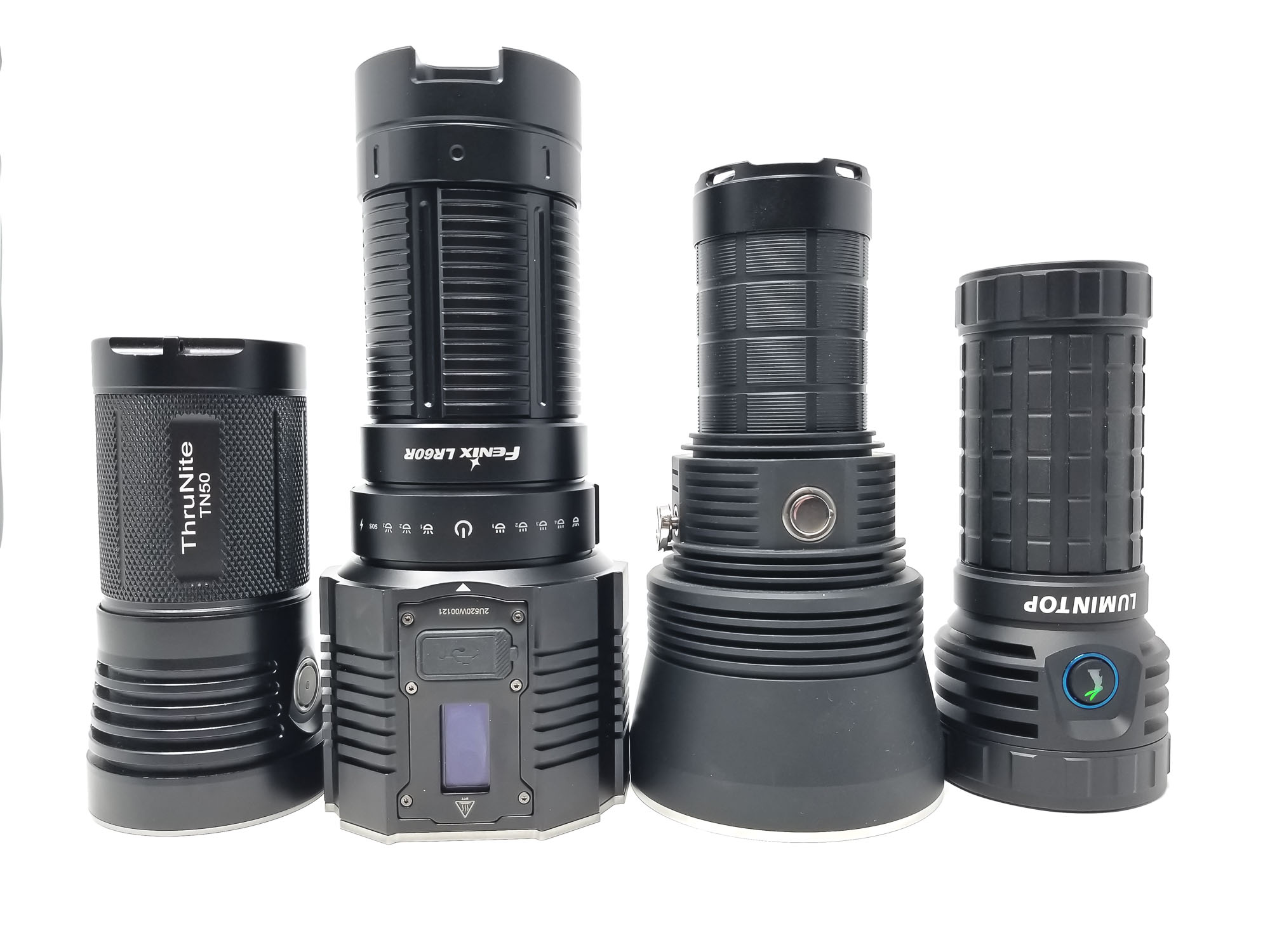
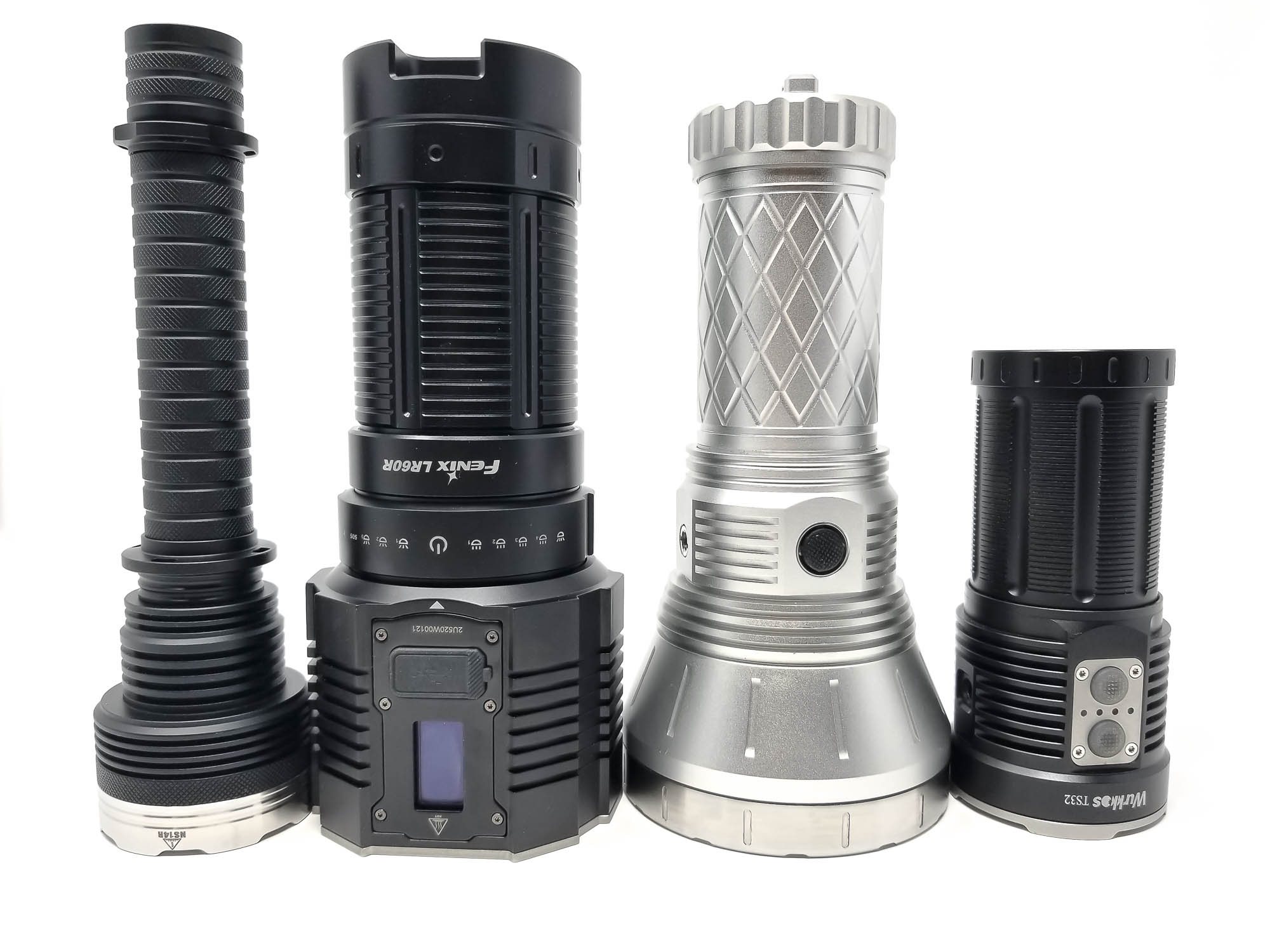
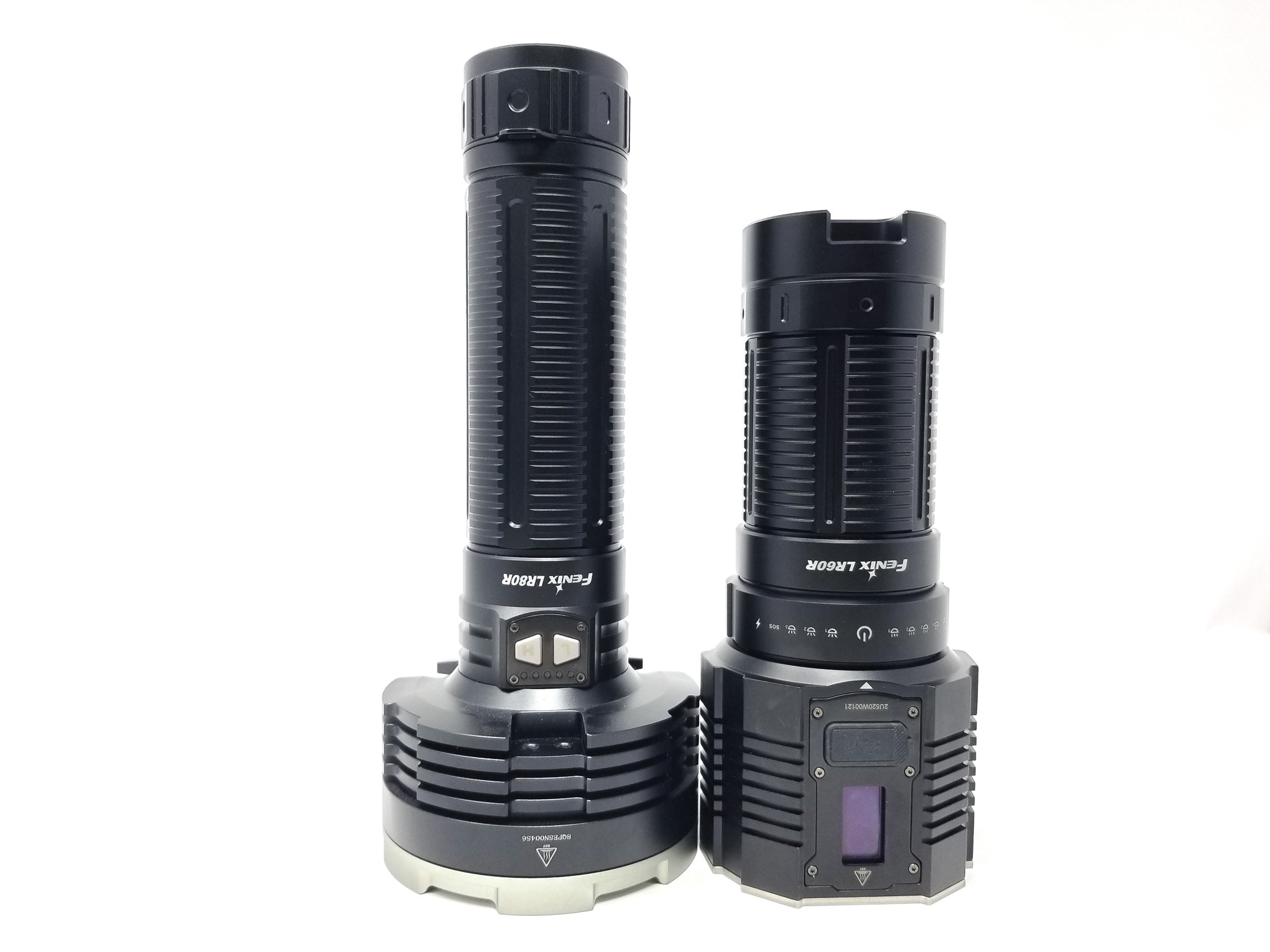
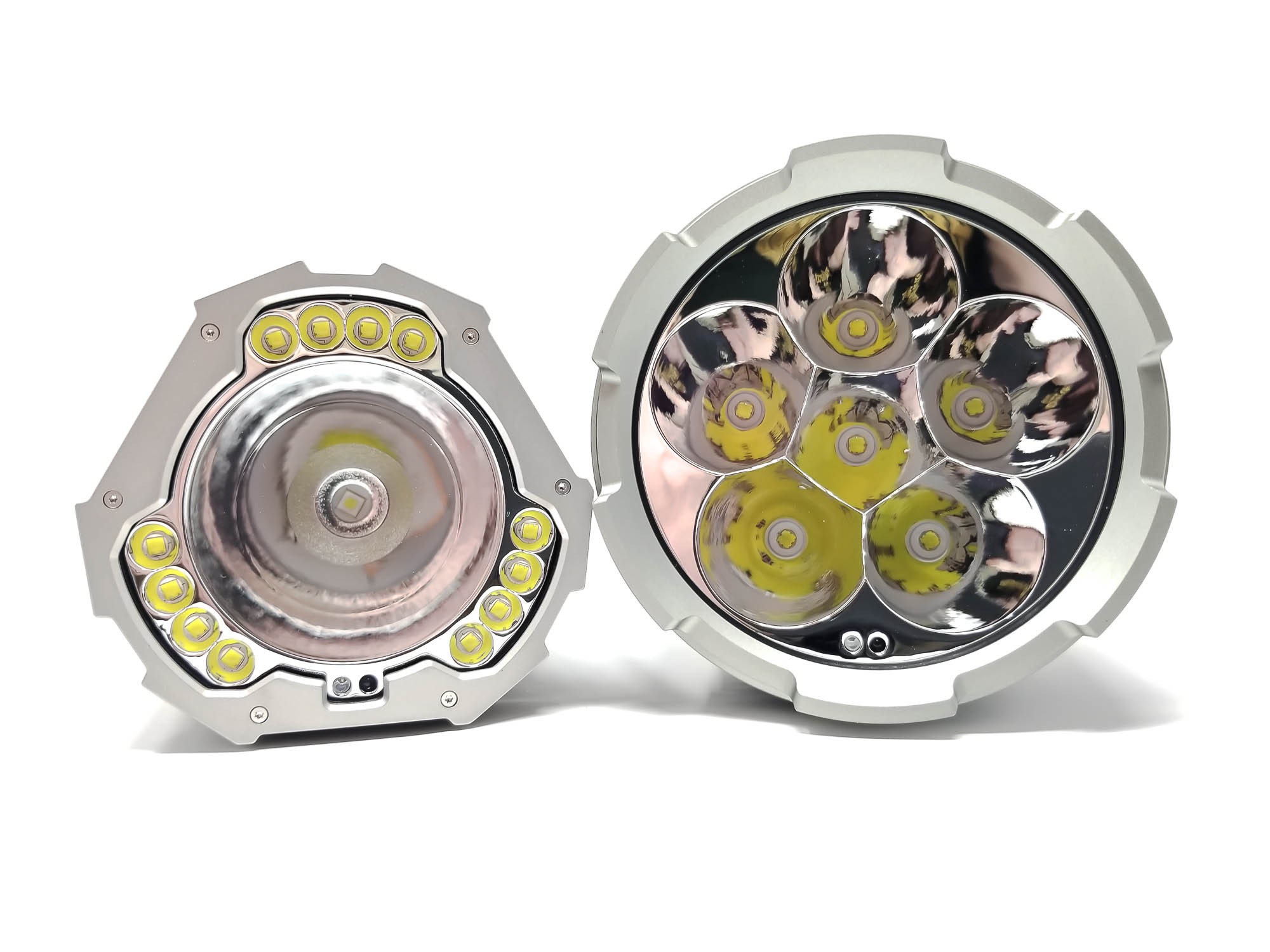
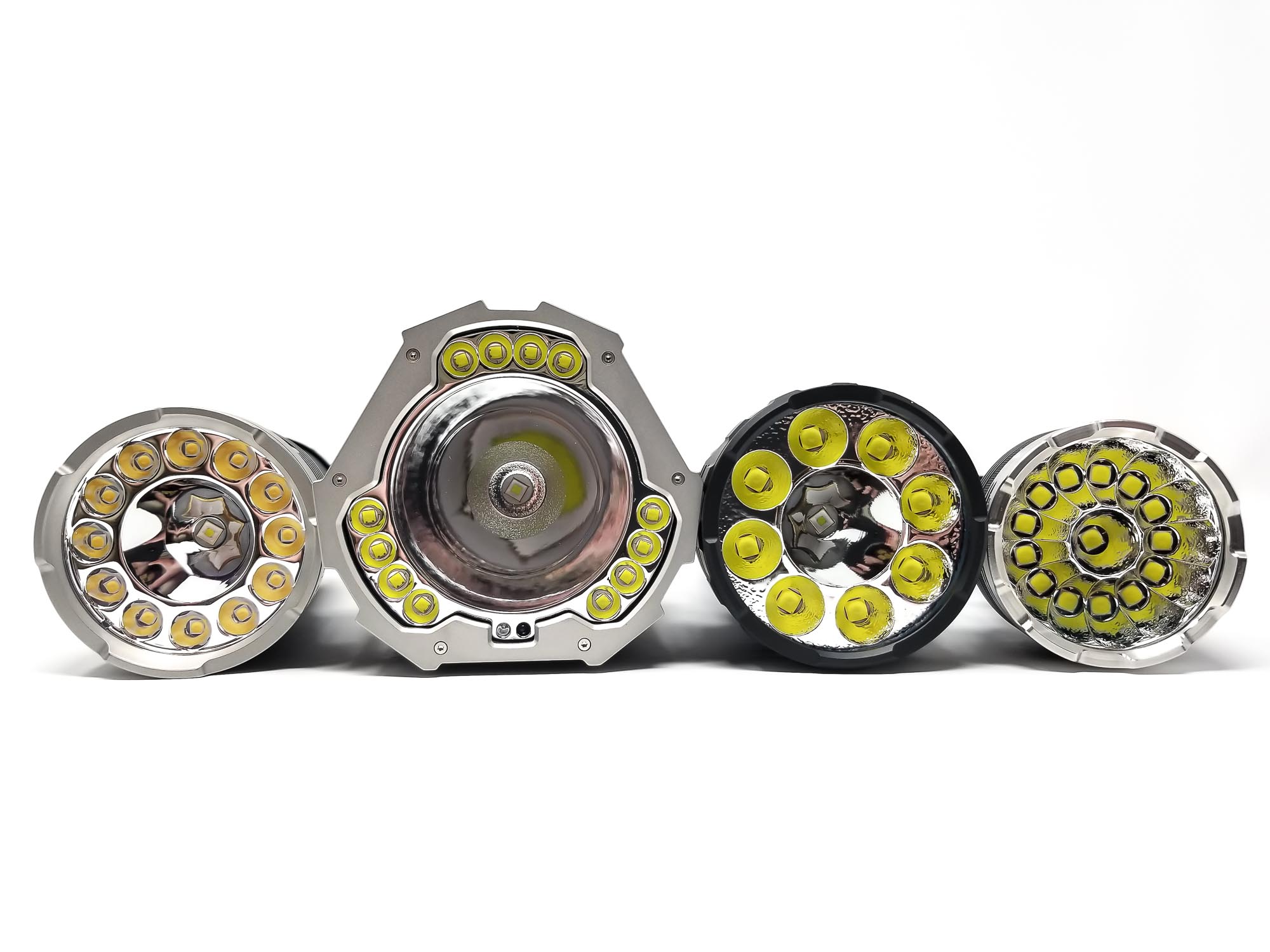
Fenix LR60R UI: User Interface and Driver
Fenix flexed their development and engineering muscles with the driver since it’s going to be a high power buck driver. The battery input is 4S for 14.4 volts, and the LEDs need 3 volts and either 6 or 12 volts (for the SFT70). It’s going to have fully regulated output for all output modes, which is essential for uninterrupted output over the (usable) battery capacity. The UI is going to be a unique one, not that the modes are wonky or spaced all wrong, rather how you switch them. One of the main features of this light is the rotary switch. There’s 5 regular modes and two blinky modes available, accessed by turning the switch right or left of center (off position), divided into two mode groups: Search Mode (left of center) and Camp Mode (right of center). It’s all super-simple to negotiate and learn.
Available modes in Search Mode:
- Eco, Low, Medium, High, Turbo (spotlight and floodlight max outputs combined)
Available mode groups in Camp Mode:
- Medium, High, Turbo, Strobe, S.O.S.
Available blinky modes:
- Strobe, S.O.S.
From OFF Position:
- Turn rotary switch clockwise: Turns on in Search Mode Eco
- Turn rotary switch counterclockwise: Turn on in Camp Mode Medium
From ON Position in Search Mode:
- Turn rotary switch clockwise: Switches modes in sequence Eco, Low, Medium, High, Turbo
- Turn rotary switch counterclockwise: Switches modes in sequence Turbo, High, Medium, Low, Eco, OFF
From ON Position in Camp Mode:
- Turn rotary switch counterclockwise: Switches modes in sequence Medium, High, Turbo, Strobe, S.O.S.
- Turn rotary switch clockwise: Switches modes in sequence Strobe, Turbo, High, Medium, OFF
Mode memory:
- N/A
Shortcuts:
- N/A
Low voltage warning/protection:
- Yes. The light will drop the output to Eco mode and the OLED display will flash to indicate low voltage and recharge the battery.
Strobe/blinkies
- Strobe, S.O.S.
Lock-out mode:
- None, but the light can be disabled by unscrewing the tailcap 3 turns
PWM
- None visible
Additional/summary info on the UI:
- I can see the logic behind a rotary switch after playing with the LR60R a bit. To be honest, I wasn’t a huge fan of the rotary switch on the PD40R, but I feel like Fenix improved on it with the LR60R. The switch is easier to manipulate one-handed with the addition of the grooves on the ring (the main issue I had with that other light). For the modes, you get a bunch of useful, well-spaced modes and I like how the blinkies are at the end of the Camp Mode to keep them out of the ‘rotation.’ The maximum brightness for Turbo on Camp Mode is all of the flood LEDs combined, but for Turbo in Search Mode, the floodlight and spotlight LEDs are activated at max brightness. The spotlight goes up to High for Search Mode (3,000 Lumens).
- The downside of the rotary switch (all rotary switches), is you don’t get mode memory, and to get to a certain mode you want, you’ve got to switch through the other modes along the way. There’s no shortcuts either, so if you want Turbo, you’ll be switching through every Camp or Spotlight Mode set to get to it. Fenix also added the proximity auto-dimming sensor to the LR60R, which drops the output to Eco if an object is within 60 mm (2.36”) per the manual. It’s very obtrusive and works on all modes besides Eco, so it dims even on Low mode, which is annoying since really only High and Turbo can cause damage to objects. Thankfully, it can be disabled: From off, turn the rotary switch from the off position to the Eco position quickly 3 times. The display will show ‘off’ and the light will flash 3 times. To reactivate the sensor, repeat the process. The light will remember the setting, so if you ever want it turned back on, you’ll need to do that.
Fenix LR60R Charging and batteries
The LR series use multiple batteries, either in series/parallel or series arrangements. The LR60R adopts Fenix’s brand-new ARB-L56-4000 battery pack. This is a 4000 mAh 14.4 volt battery pack made up of four 4000 mAh 21700s. It’s fully kitted out with a BMS and protection board with the full suite of li-ion safety features. It’s also proprietary, with integrated positive and negative contacts at the anode and cathode which match up to spring-loaded pogo contacts at the back of the driver, so it can’t use any other battery options besides this one.
I’m totally fine with that in this application, and I’m sure Fenix stuck their excellent ARB-L21-4000P 21700 in the pack. It’s going to be a mid current cell, probably good for 15 to 20 amps CDR, more than enough for the power demands of the LR60R. Charging is very modern, with a dual-input output bi-directional charging capability (power bank) over USB C and a USB A. The USB C is for charging input, but I did get it to work for the power bank as well. Fenix spec’d 45W max for the charging, so 20v 2.5a (when connected to an appropriately-rated power supply), and in addition to PD, it also charges at QC2 and QC3. The power bank follows the same protocols up to 45W also. Since the LR60R doesn’t come with a charger, I plugged the LR60R into the LR80R’s charger and depending on how the cable was oriented, I was getting between 18-24W, and up to 45W (20v 2.5a) which is very impressive.
After a runtime test, a depleted battery was fully recharged in 1 hour 33 minutes on the nose and added 2991 mAh per the USB meter. On the power bank side, I got it to recharge the Fenix HT18R over C to C at a fairly standard 5v 2a, and it happily charged over PD as well. I plugged in the Nightwatch Super Valkyrie, which is supposed to support 45W charging. On C to C charging, the output bounced around a bit, but I did get it to charge at nearly 45W. Very impressive!
| Charge type | Fits | No fit | Charge time |
|---|---|---|---|
| USB type C | Included battery back only | Everything | 1h 33 min |
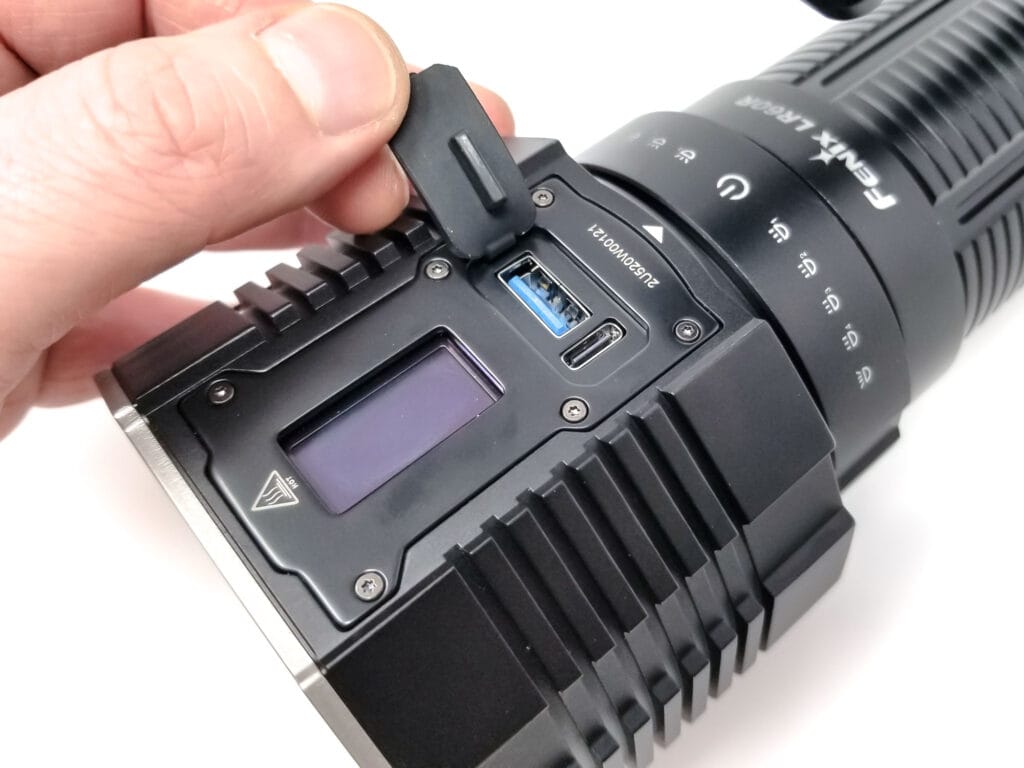
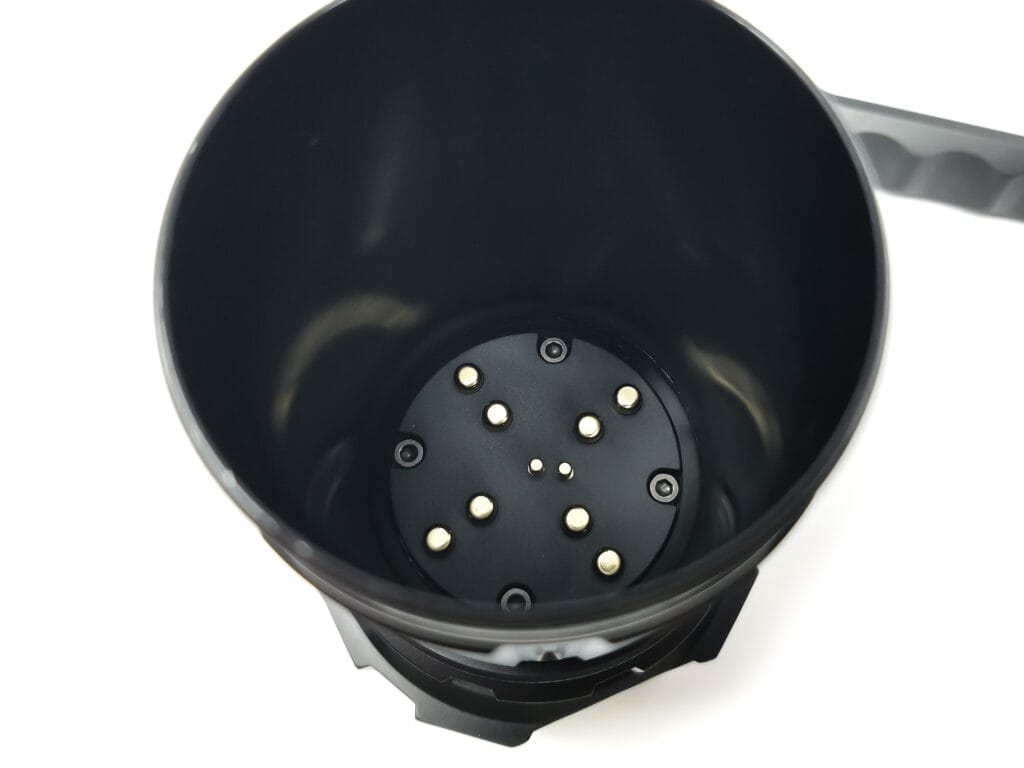
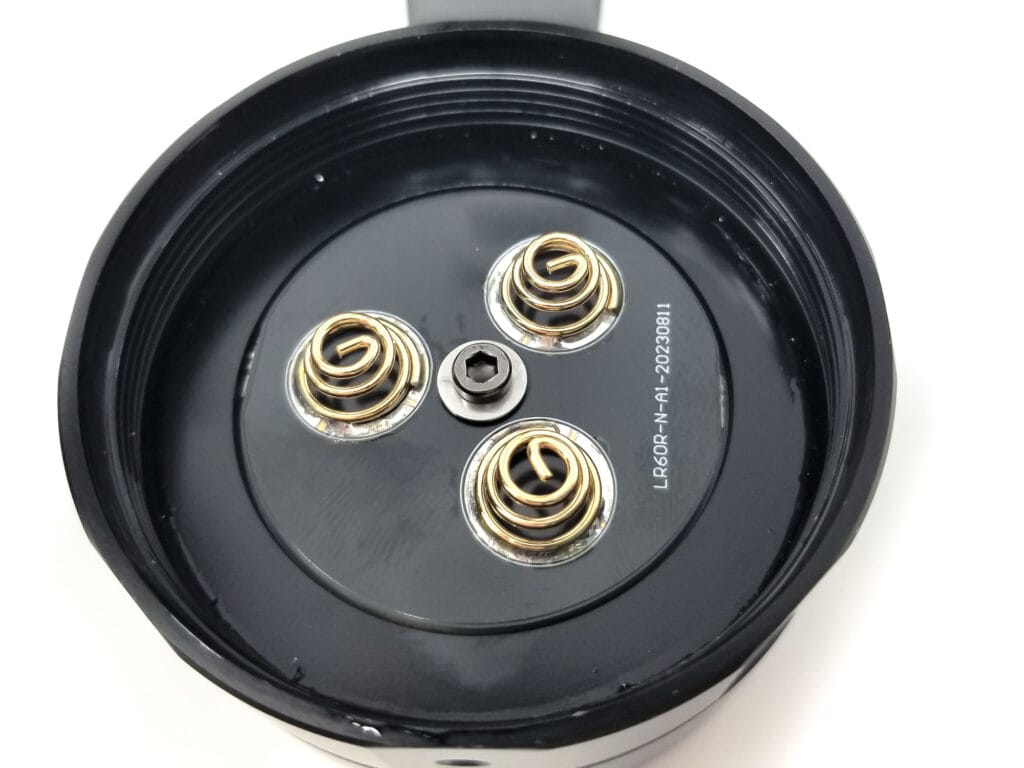
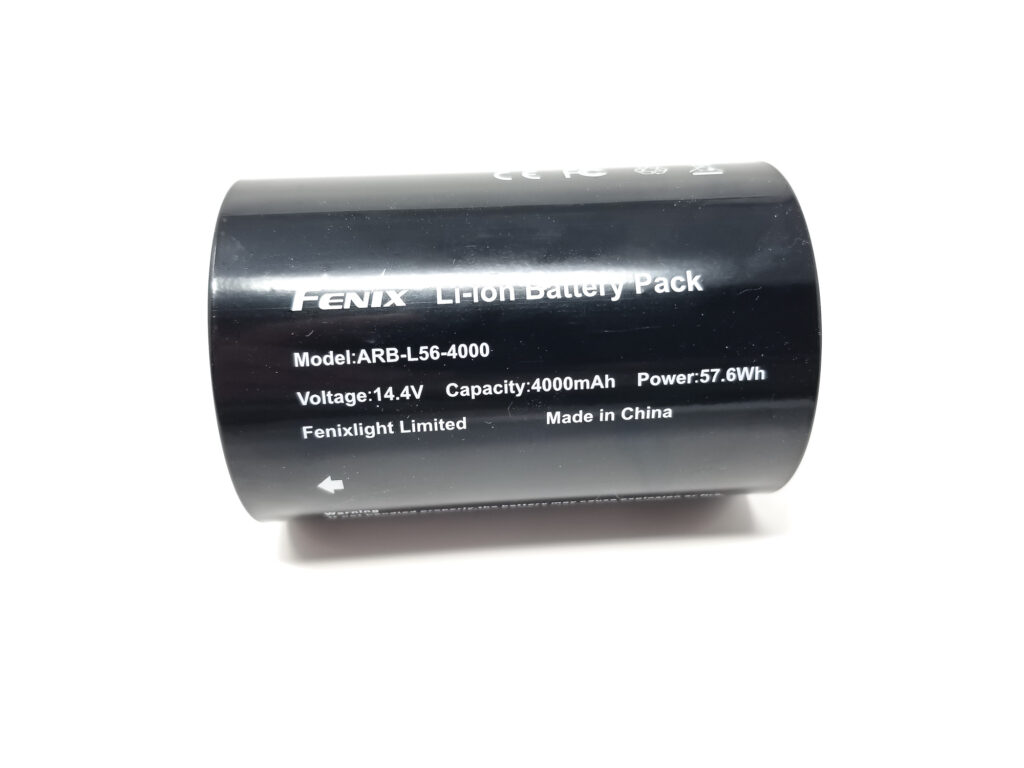
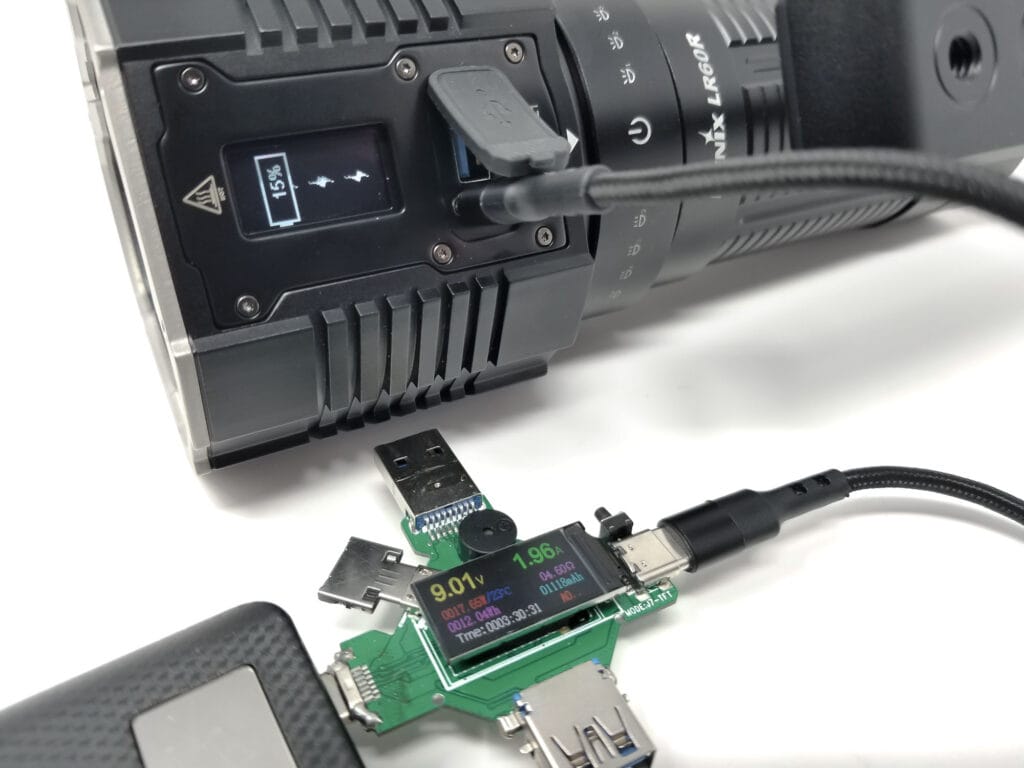
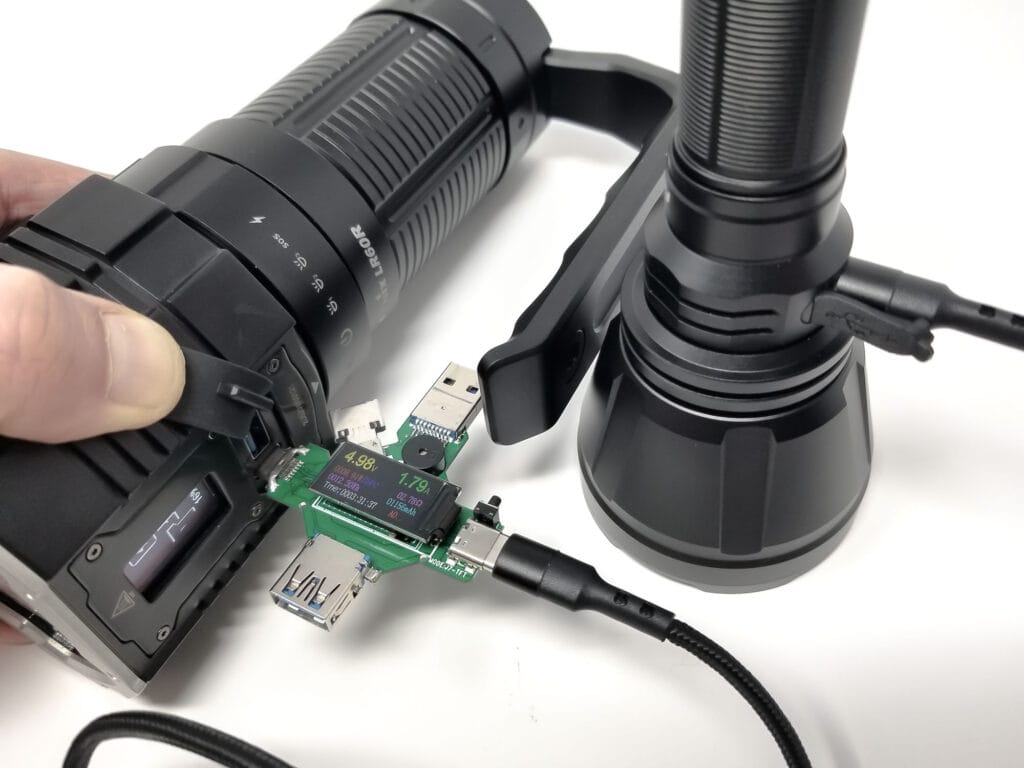
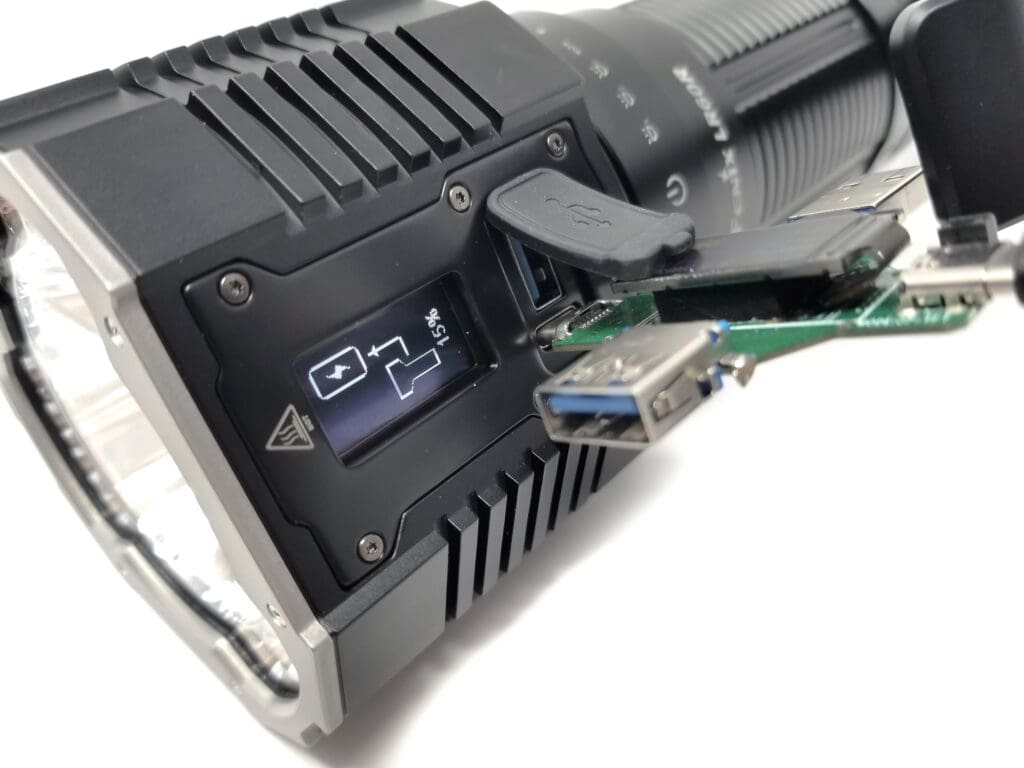
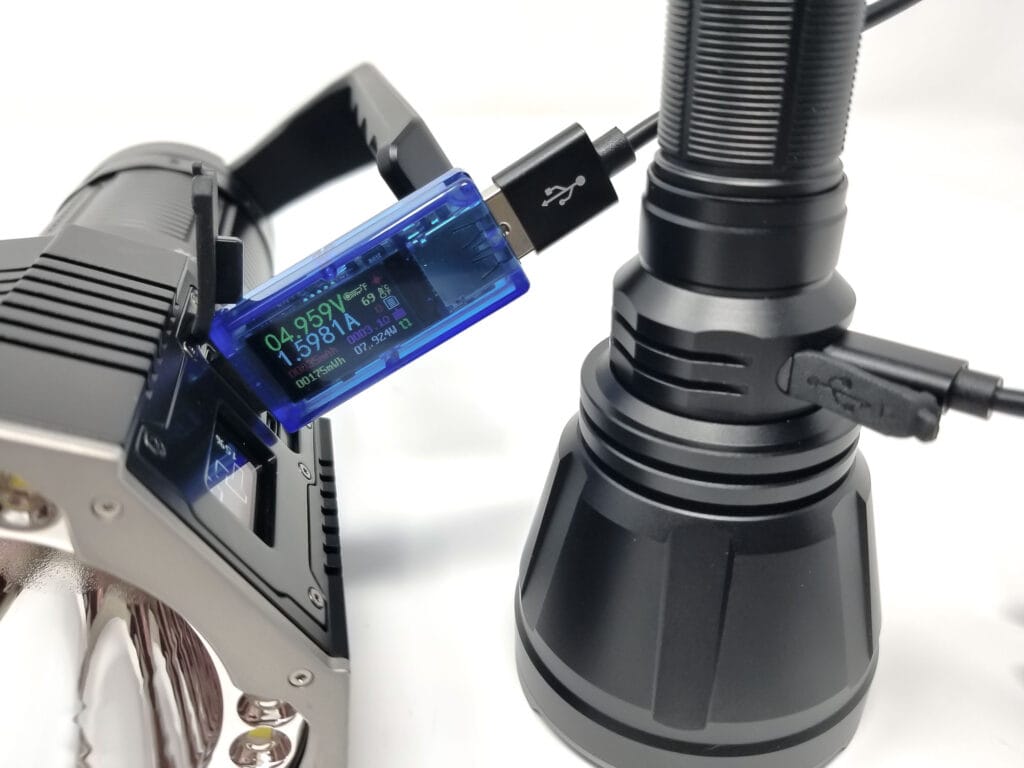
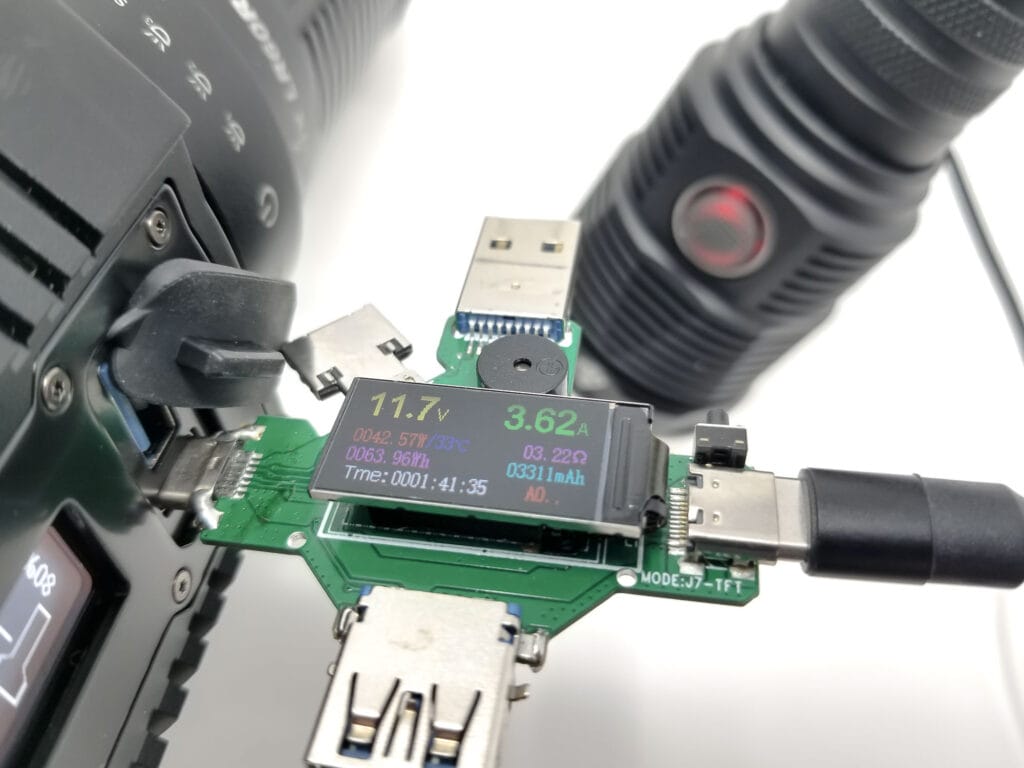
Performance test
Lumen measurements
How Lumens are Measured: Understanding ANSI FL1 Standards How Lumens are Measured: Understanding ANSI FL1 Standards: The ANSI FL1 standards specify that output in lumens should be measured 30 seconds after turning on, as this is the standardized time for measuring brightness according to the industry standard. This is why we focus on this part in our measurements. The ANSI FL1 standards require an ambient temperature of 22 ± 3°C. We record the ambient the ambient temperature to identify potential reasons for any observed discrepancies.Lumens are measured in my integrating tube, which is made from a 4” to 3” closet elbow and two 3” street 90s with an end cap. I use a Digi-Sense 20250-00 data logging luxmeter. The integrating device has been calibrated with a Convoy S2+ measured to 260 Lumens and the figures are within 10% of actual. No current measurements this time due to the isolated current path. Measurements were taken with the fully charged Fenix ARB-L56-4000 battery pack.
| Mode | Specs | @turn on | @30 sec | @10 minutes |
|---|---|---|---|---|
| Searchlight Mode | ||||
| Eco | 50 | 52 lm | 52 lm | – |
| Low | 300 | 298 lm | 298 lm | – |
| Medium | 1000 | 1029 lm | 1029 lm | – |
| High | 3000 | 3038 lm | 2891 lm | 2077 lm |
| Turbo (spot+floodlight combined) | 21,000 | 20,090 lm | 18,326 lm | 3234 lm |
| Camp Mode | ||||
| Medium | 2000 | 2018 lm | 2009 lm | 1989 lm |
| High | 6000 | 5978 lm | 5880 lm | 5096 lm |
| Turbo | 15,000 | 15,288 lm | 14,602 lm | 3430 lm |
Parasitic drain:
- N/A
The outputs look really good and track Fenix’s specs, as I expect from a $400+ flashlight of this type. The mode spacing is good for the applications as well, and you have tons of light and beam distance at your disposal to call up when needed. Good stuff!
Fenix LR60R Battery Life: Runtime graphs
How Runtimes are Measured: Understanding ANSI FL1 Standards About ANSI FL1 runtime standards: The runtime is measured until the light drops to 10% of its initial output (30 seconds after turning on). This does not mean that the flashlight is not usable anymore. The last column shows how long the light actually works till it shuts off. If there is a + symbol, it means that the test was stopped at that particular point, but the light was actually still running. This happens on certain occasions, with certain drivers, firmware, or batteries.Runtimes are measured in my integrating tube with a Digi-Sense 20250-00 data logging luxmeter. The integrating device has been calibrated with a Convoy S2+ measured to 260 Lumens and the figures are within 10% of actual. I use a Digi-Sense 20250-92 data logging thermocouple for the temperature measurements. The probe is affixed to the head using kapton tape and uses the same 5 second sampling rate for logging. The Fenix ARB-L56-4000 battery was fully charged for each runtime.
| Mode | Specified runtime | Measured runtime ANSI | Time till shut off |
|---|---|---|---|
| Search Mode | |||
| High | 3h 45m | 3h 39m | 3h 39m+ |
| Turbo (spotlight+floodlight combined) | 1h 50m | 1h 45m | 1h 45m |
| Camp Mode | |||
| Medium | 5h 25m | 5h 16m | 5h 16m+ |
| High | 3h | 3h | 3h |
| Turbo (floodlight) | 2h 10m | 2h | 2h |
The runtimes, like the output results, are on point, with great sustained and laminar output across all runtimes. Turbo for both Camp and Search modes steps down due to temperature, and the thermal graphs show some regulation, but it’s very seamless and unobtrusive, with the light never getting over 52 C during the long runs, and well under that for Medium mode.
The LR60R performs as advertised here, providing many thousands of Lumens for a long time (and great beam distance in Search Mode). The comparison graphs include some other flood/throw hybrid lights (the Thanos 23, Wurkkos TS32) and some multi-LED searchlights like the LR80R, Amutorch DM80 and the amazing Wuben A1. The LR80R outclasses the LR60R, mostly due to the larger battery and sheer amount of thermal mass it has. The LR60R however, has much better beam distance, is smaller, and brighter.
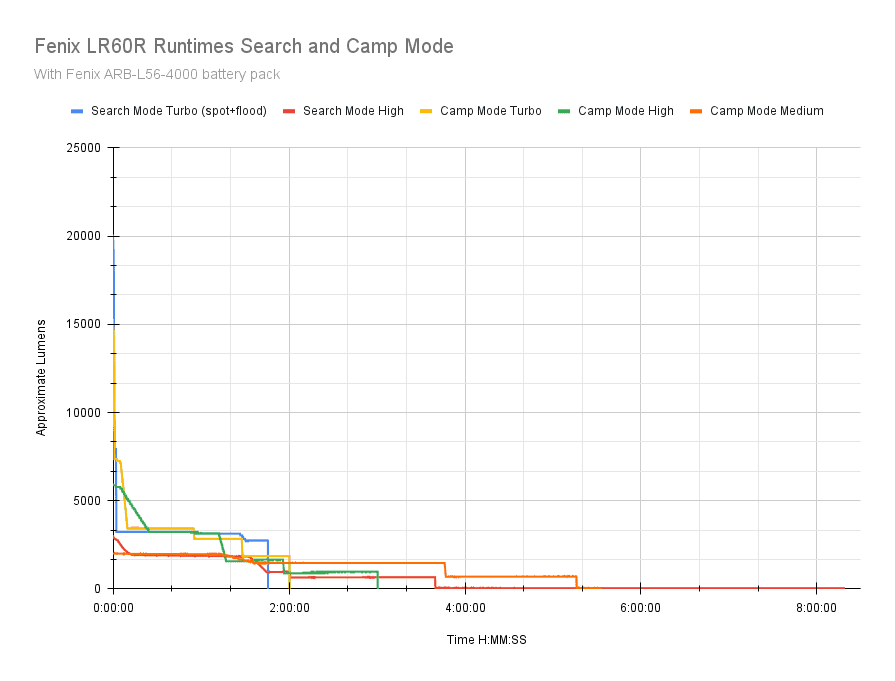
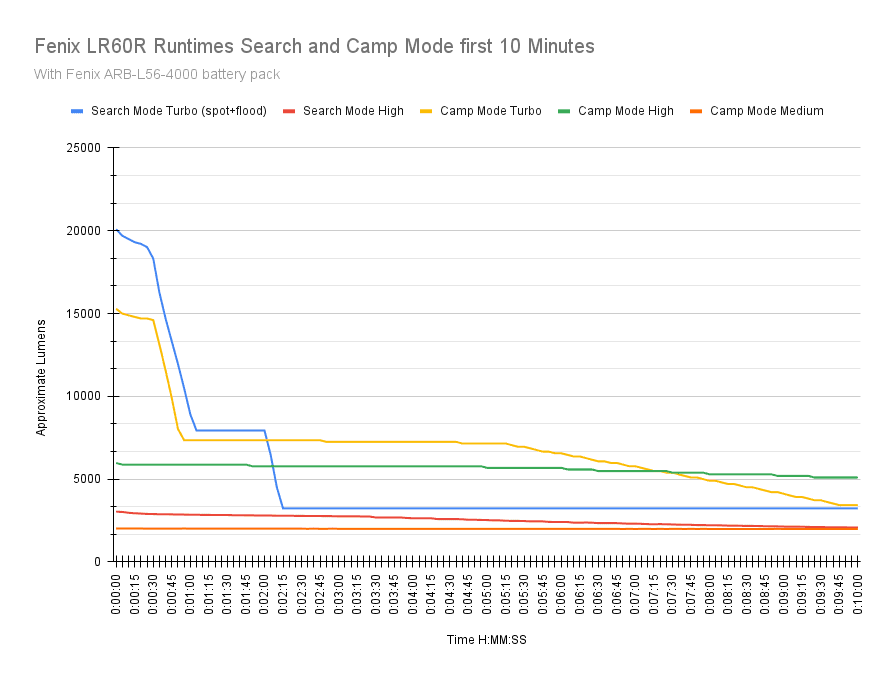
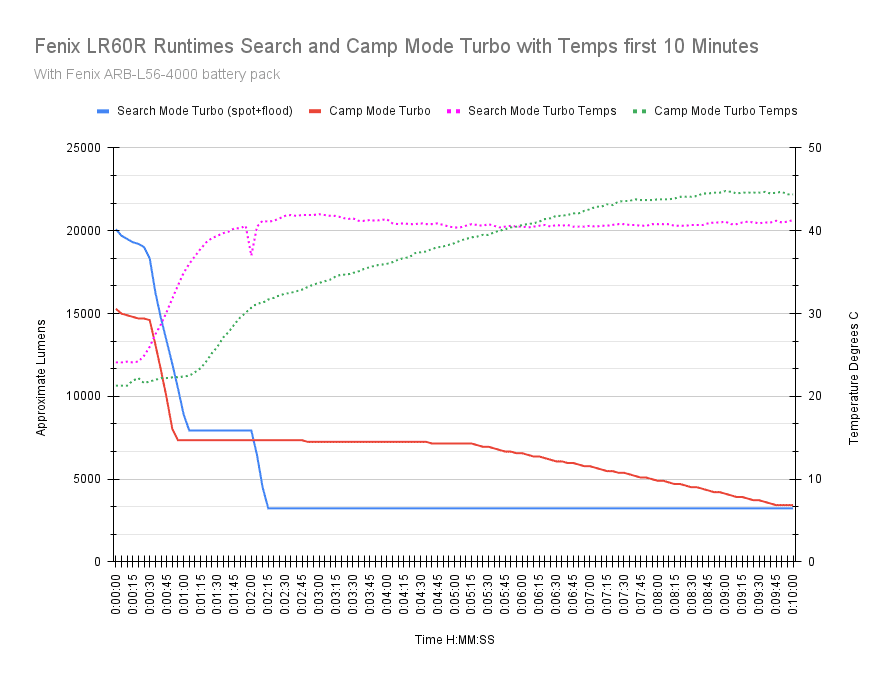
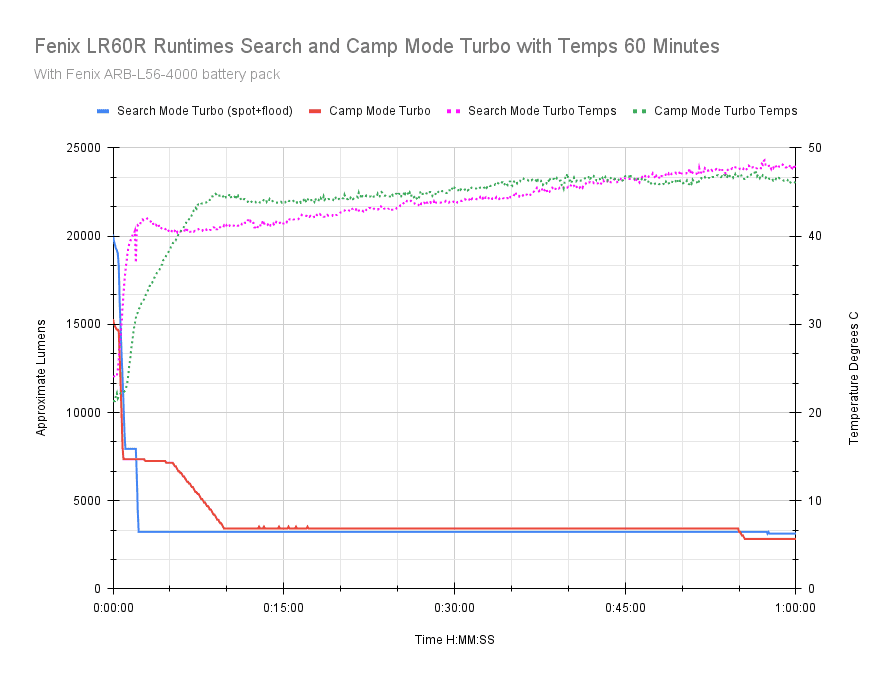
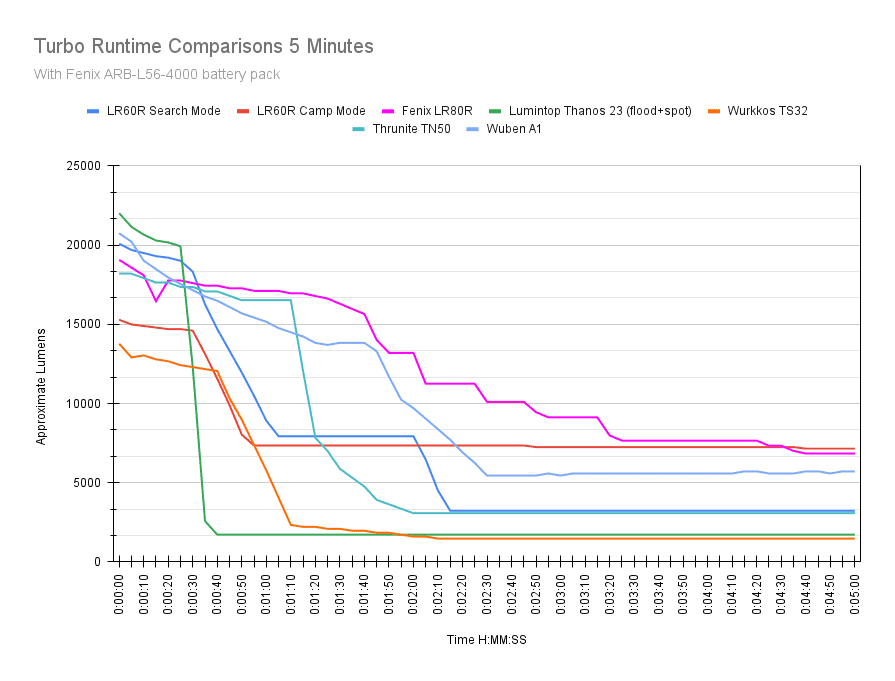
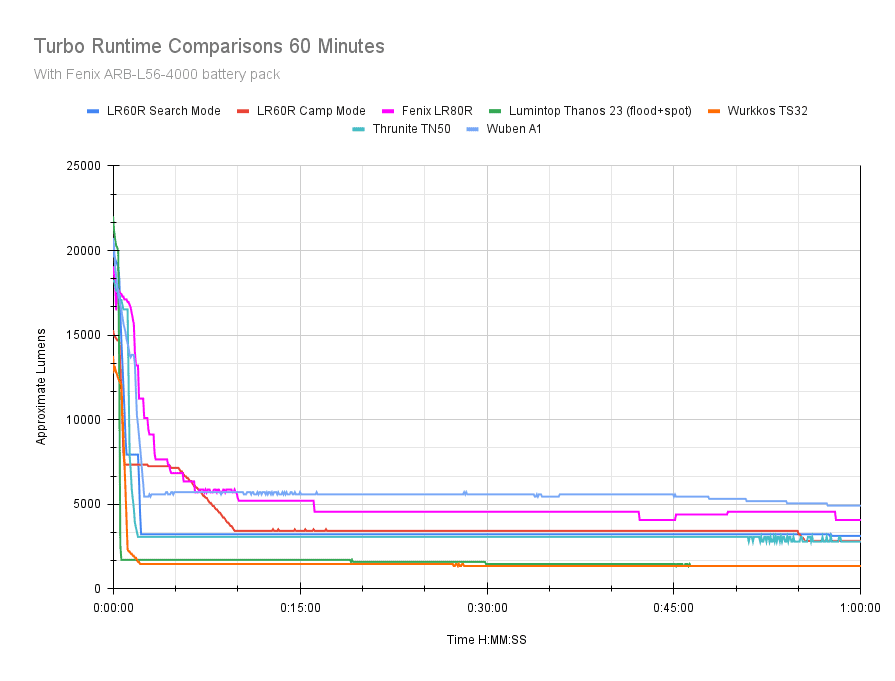
Peak beam intensity and beam distance measurements
About Peak beam intensity: Understanding ANSI FL1 Standards About peak beam intensity The calculated value of distance in meters at which the flashlight produces a light intensity of 0.25 lux. (0.25 lux is about the brightness of a full moon shining on an object). This means that the intensity has decreased so much, it becomes difficult to see darker objects, or objects that don’t reflect light. The columns ‘Meters’ and ‘Yards’ use rounded numbers.Beam distances are measured using a Uni-T UT383S luxmeter measured indoors at 5 meters using the included fully charged battery pack. Measurements taken at 30 seconds.
| Mode | Specs | Candela measured | Meters | Yards |
|---|---|---|---|---|
| Search Mode | ||||
| Eco | 4371 | 5150 cd | 143 | 156 |
| Low | 27,123 | 30,725 cd | 350 | 383 |
| Medium | 92,184 | 107,150 cd | 655 | 716 |
| High | 249,717 | 319,000 cd | 1,129 | 1,235 |
| Turbo | 294,267 cd | 312,000 cd | 1,117 | 1,221 |
| Camp Mode | ||||
| Medium | 3949 | 4375 cd | 132 | 144 |
| High | 11,839 | 13,200 cd | 229 | 250 |
| Turbo | 30,896 cd | 32,625 cd | 361 m | 395 |
The beam distance figures look good and are on point with Fenix’s factory specs. The High mode for Search is impressive, and added to the flood of Camp Mode really makes an extremely effective search and rescue beam.
Beamshots
Camera settings and distance: Photos taken with my Samsung Galaxy Note 8. For the 40 meter shots, the camera is set to ISO 200, 0.3s, and 5000K WB. For the 950 meter shots the camera is set to ISO 400 0.5s and 5000K WB. The fence is 40 meters distant and the water tower is 950 meters distant.
Beamshots of the following general purpose-use LED flashlights compared
At 40 meters
- Fenix LR60R
- Fenix LR80R
- Amutorch DM80
- Haikelite HT90
- Haikelite HK90
- Lumintop Thanos 23
- Lumintop Mach
At 950 meters
- Fenix LR60R Spotlight High
- Fenix LR60R Spot+Flood Turbo
- Haikelite HK90
- Wuben A1
- Haikelite HT90
- Wurkkos TS30S
- Thrunite Catapult Pro
Please note that beamshots are mainly intended to showcase the beam pattern and beam quality, rather than overall performance. These images are typically taken directly after activation, and do not fully represent its overall performance. For accurate performance metrics, such as output, beam distance, and runtimes, you need to look at the performance section of this review.
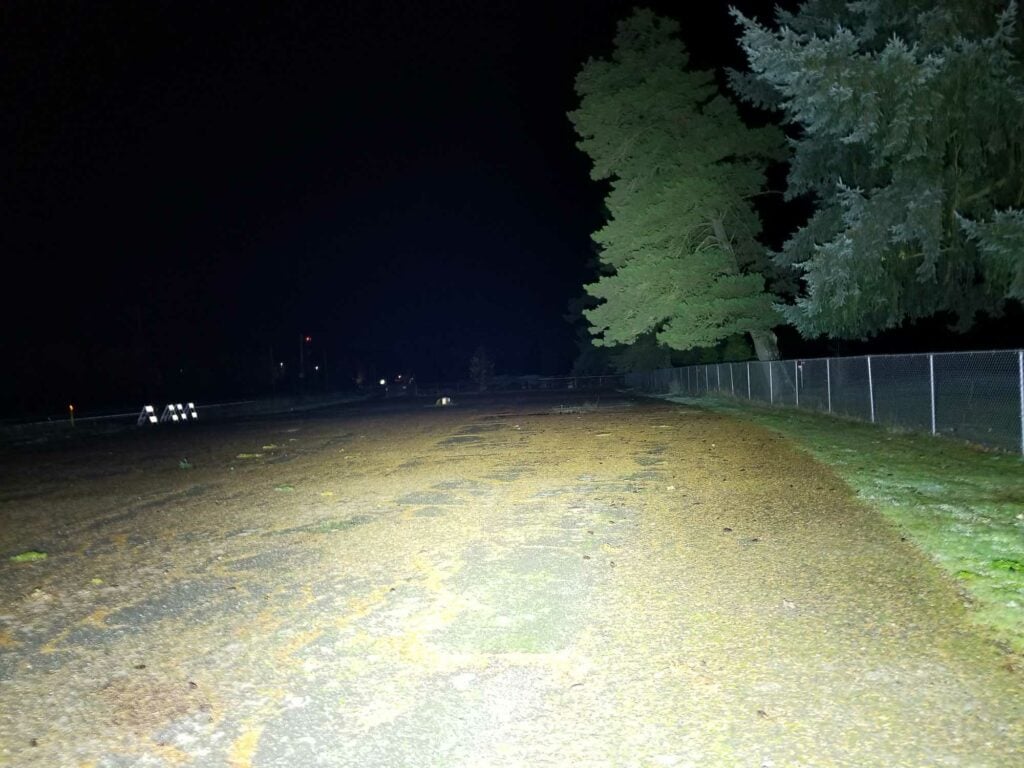
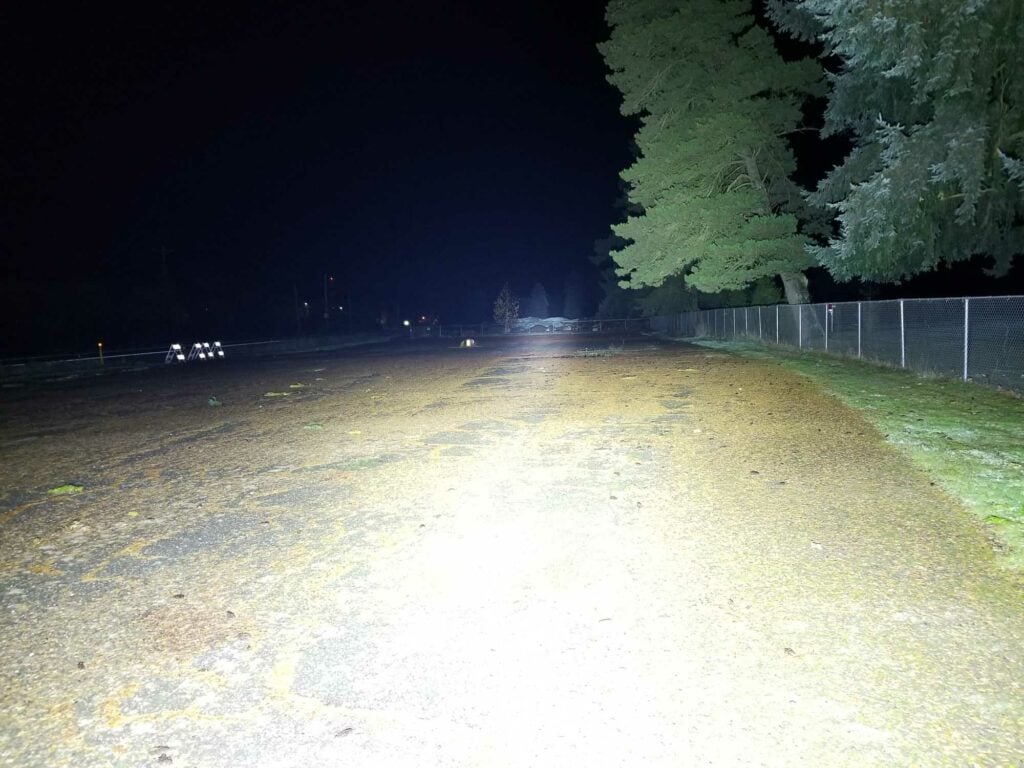
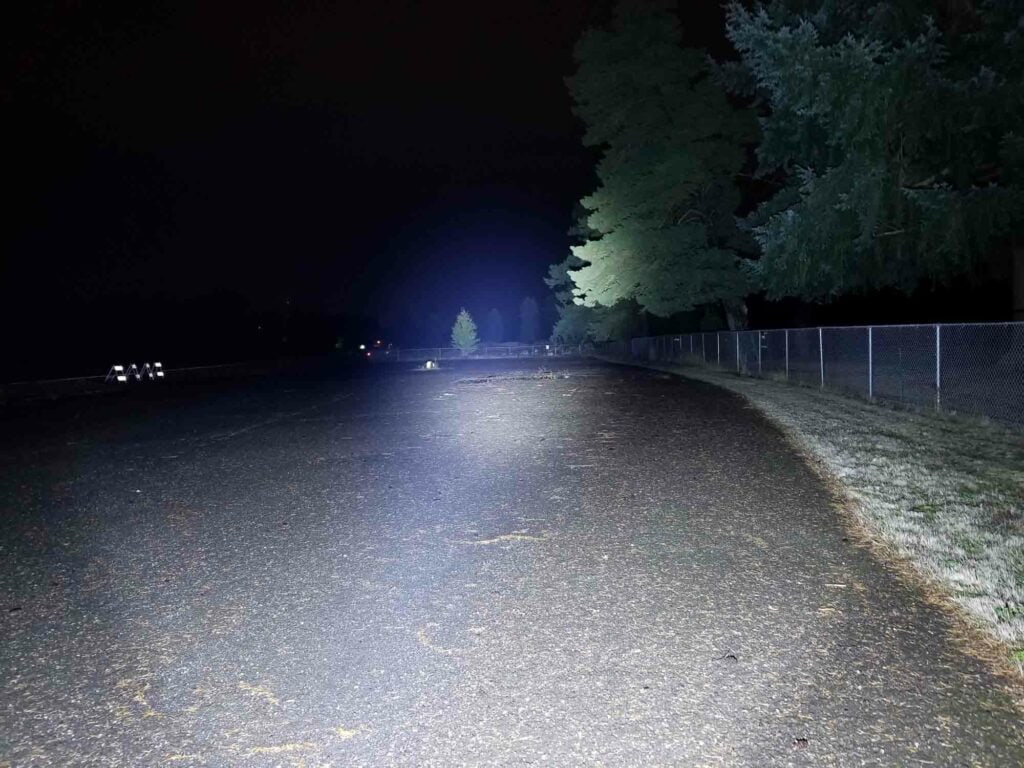
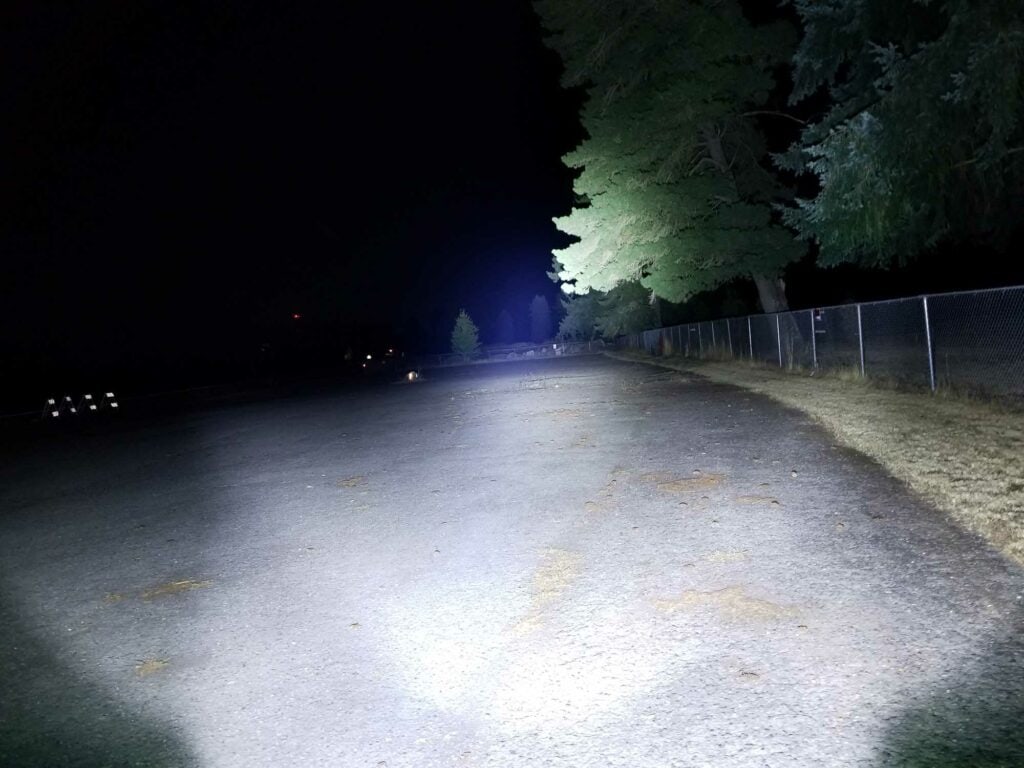
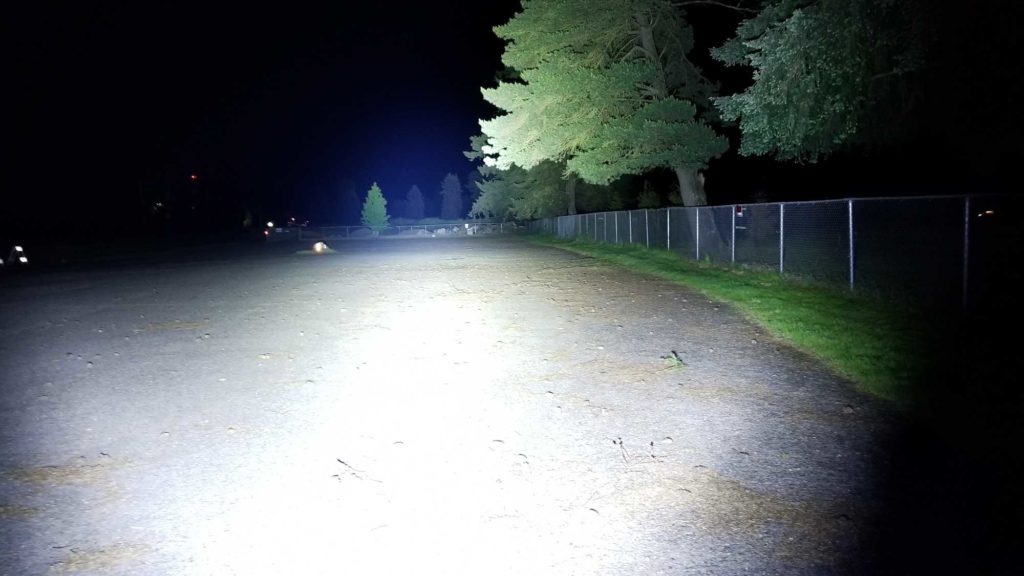
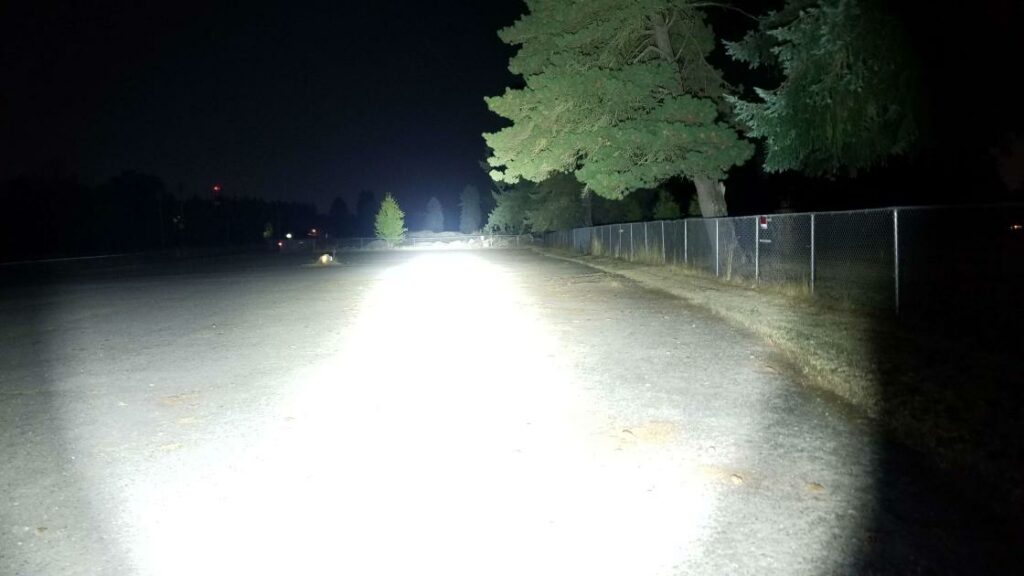
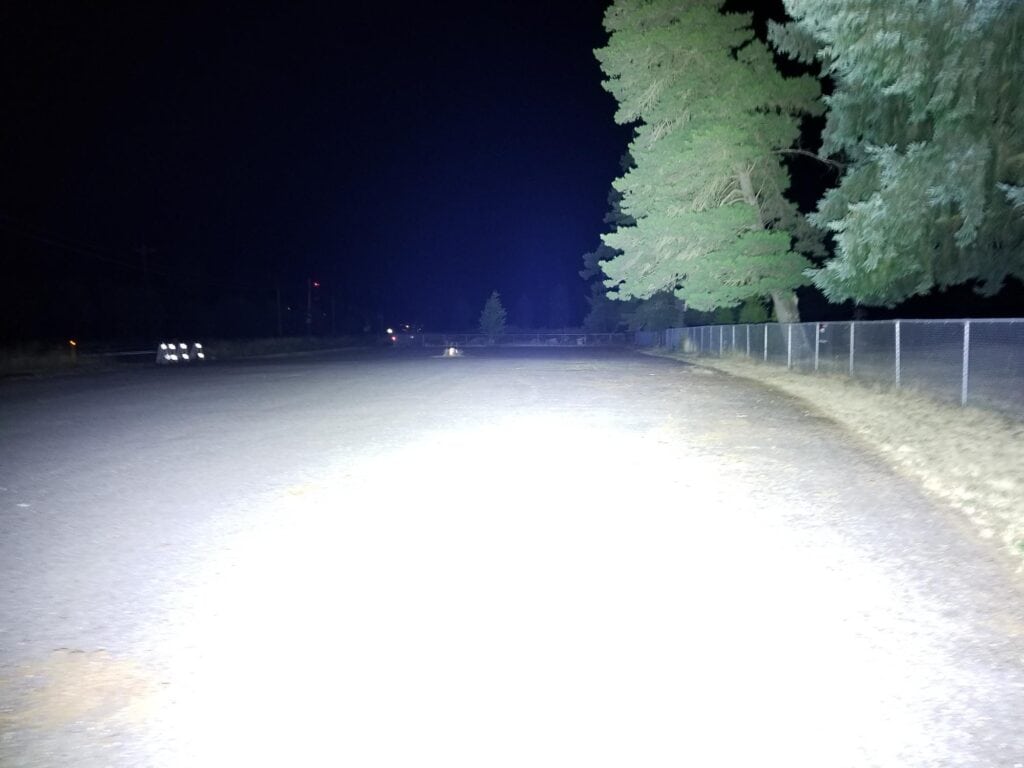
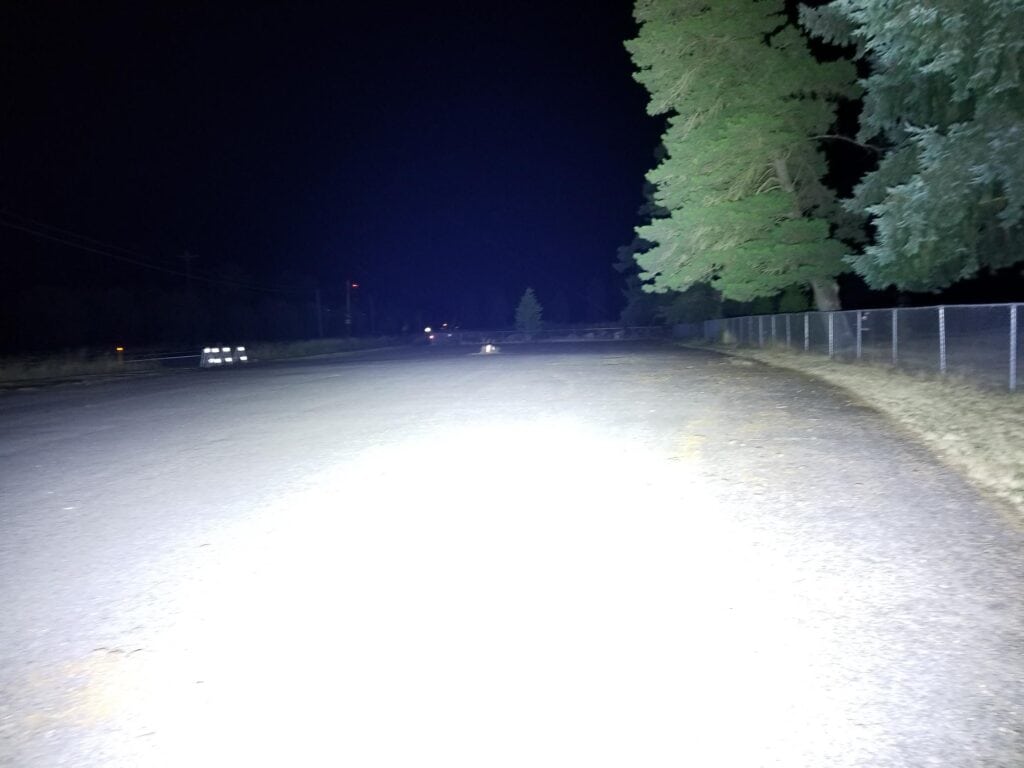
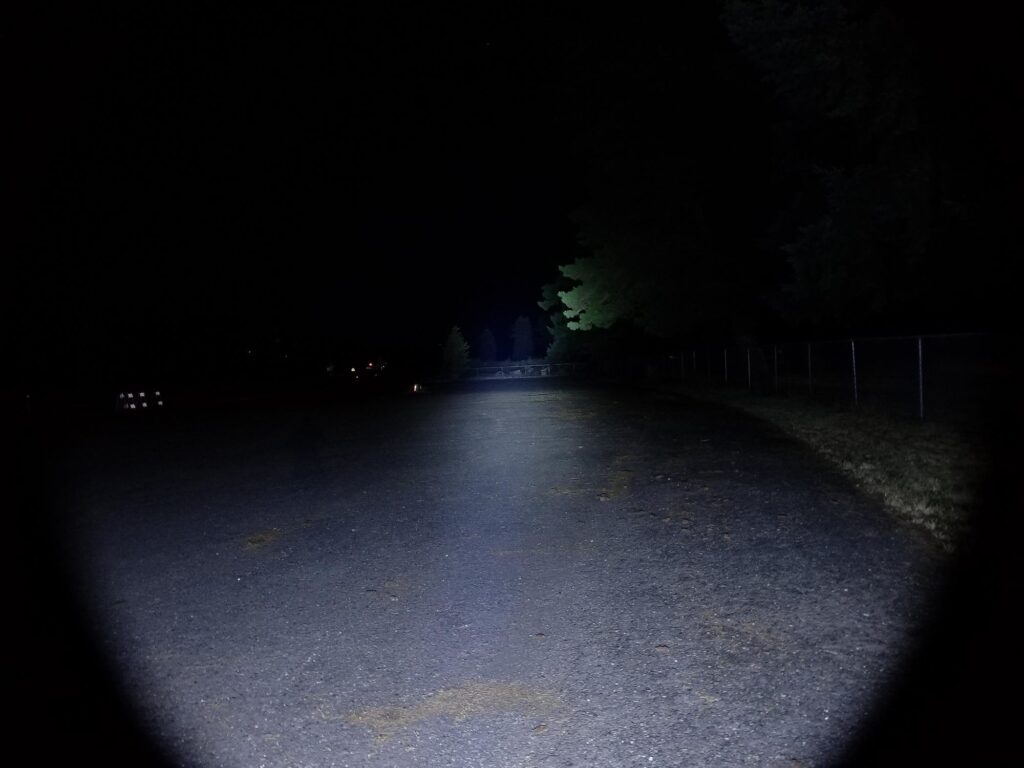
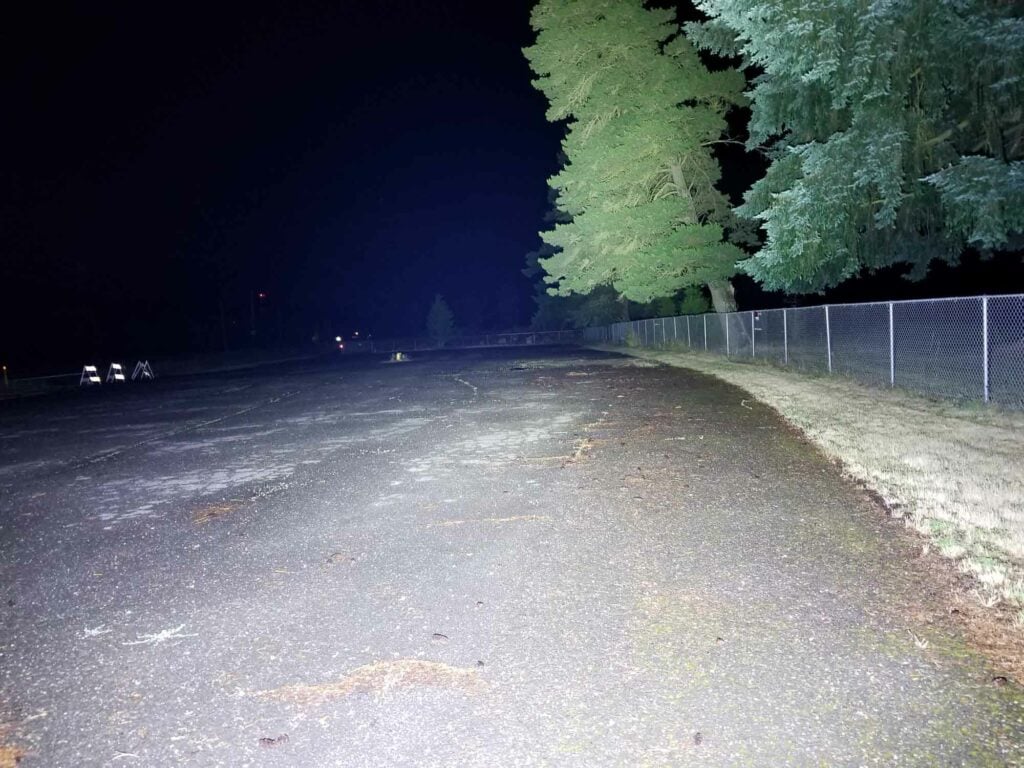
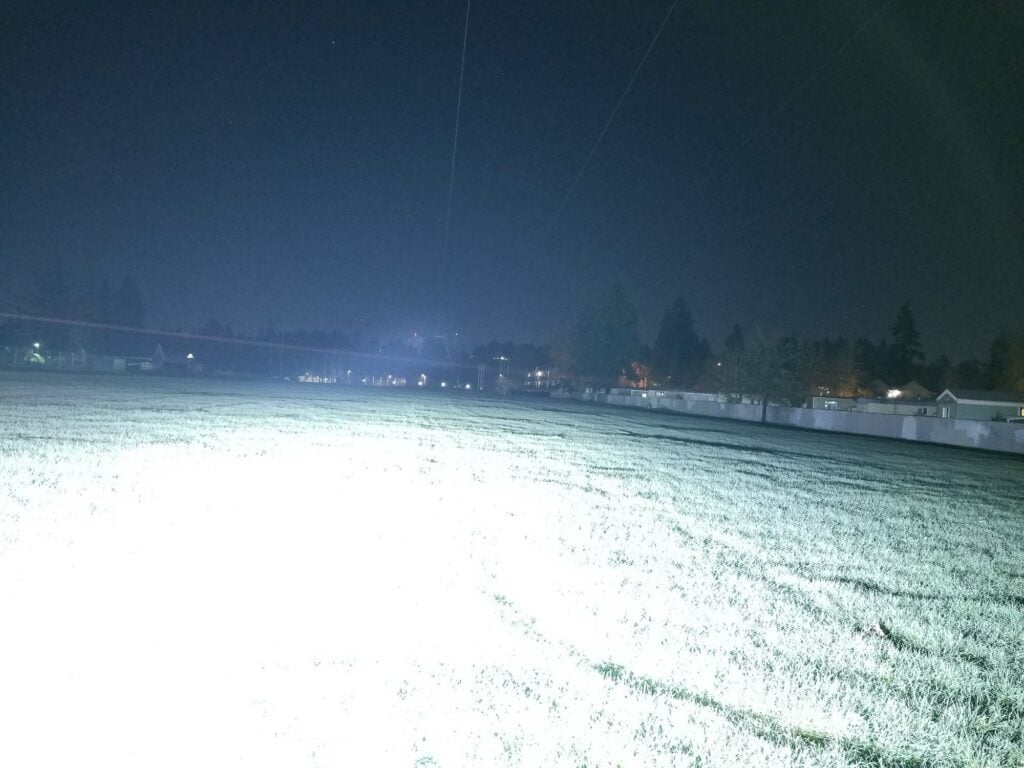
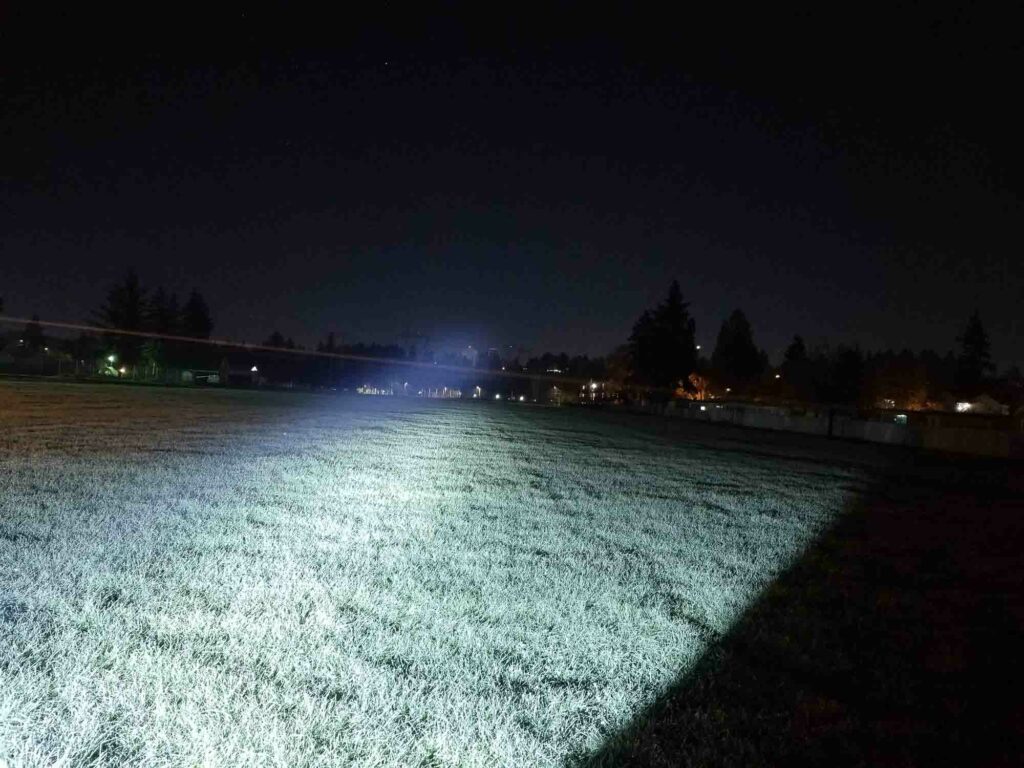
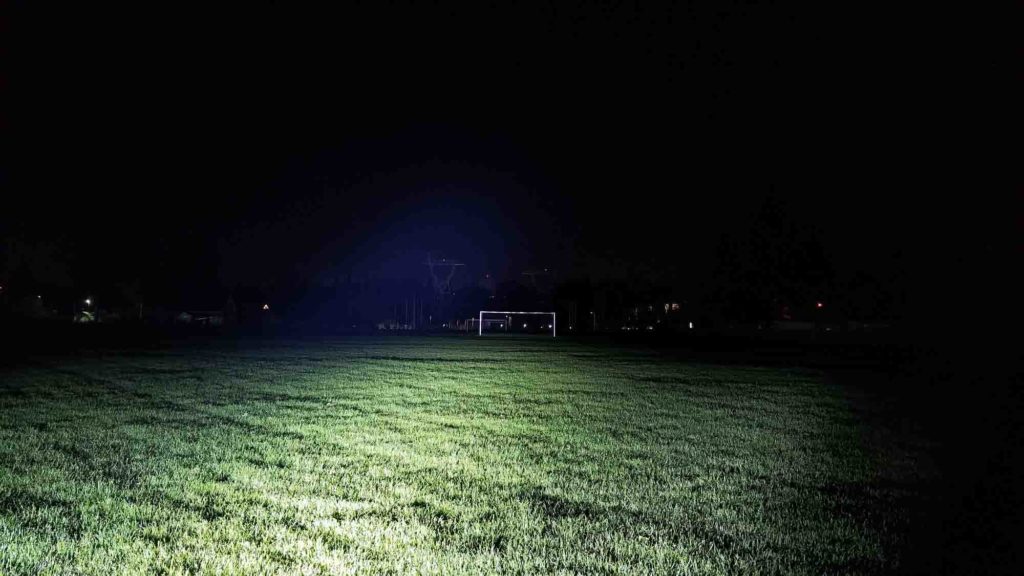
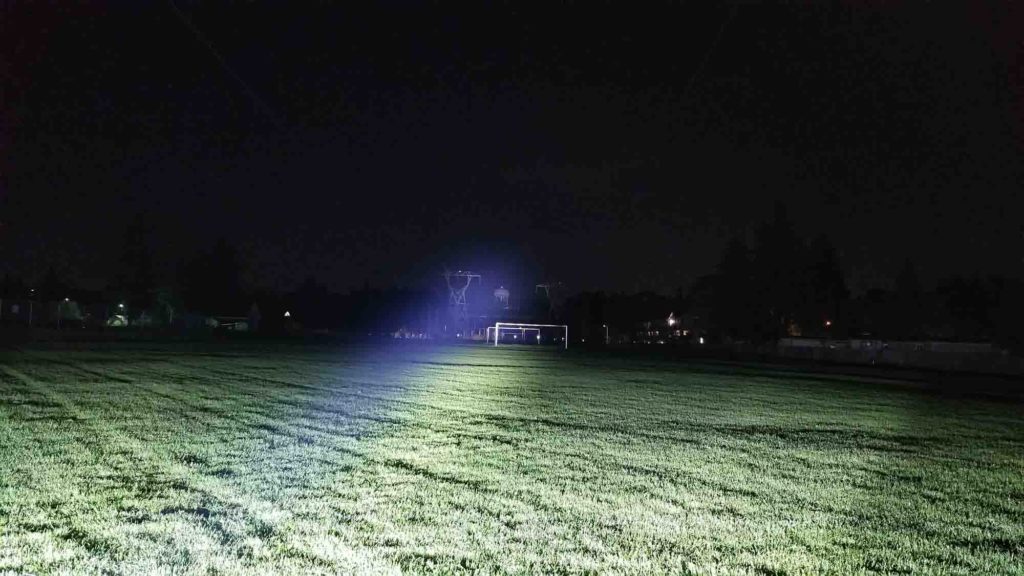
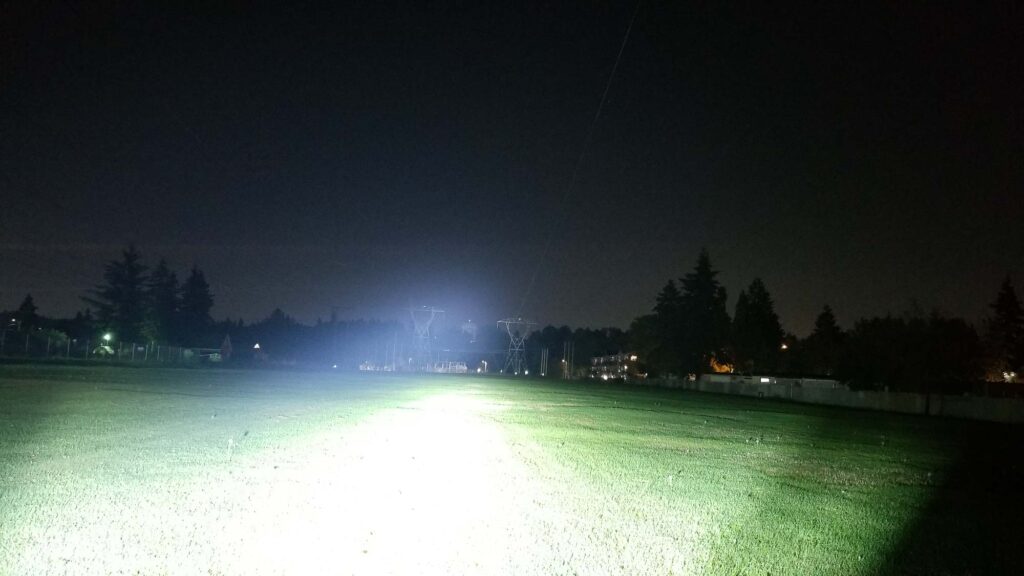
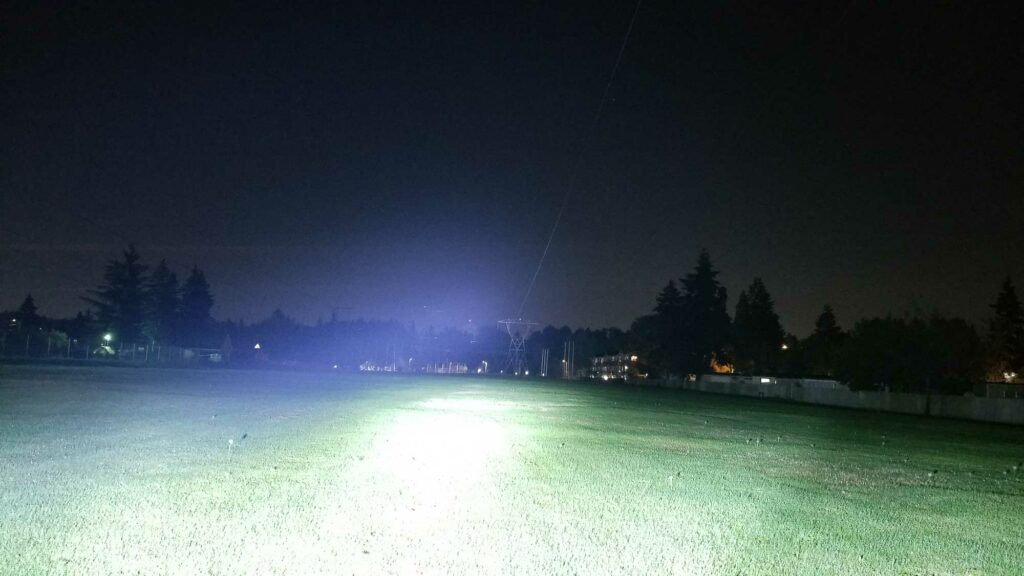
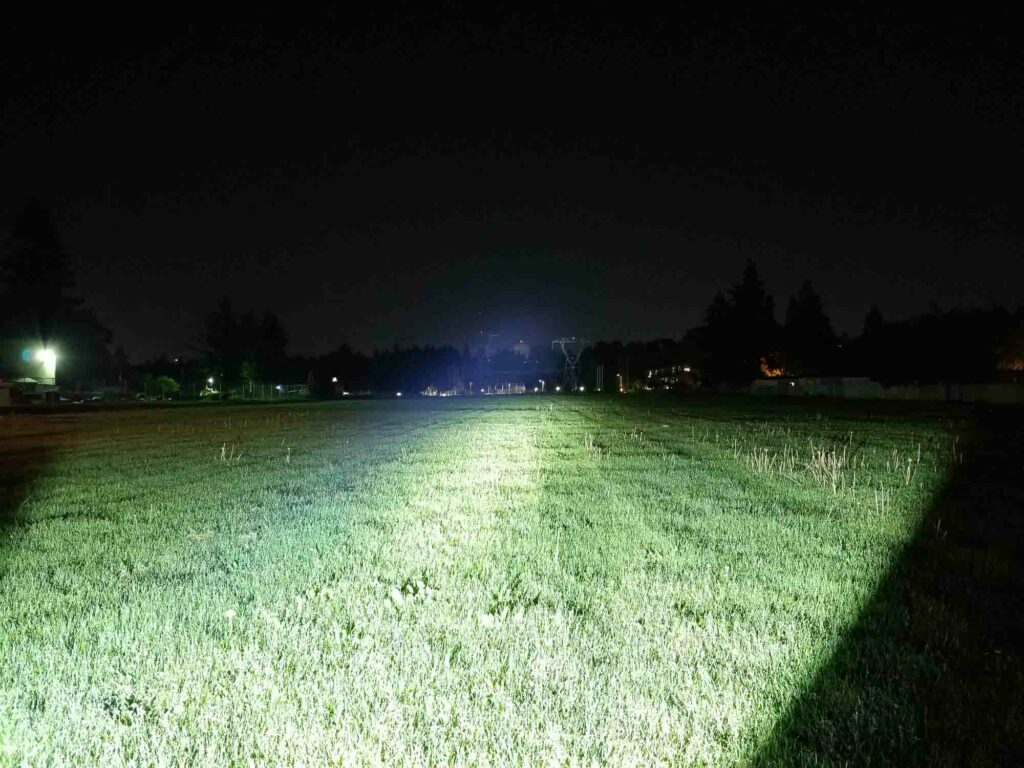
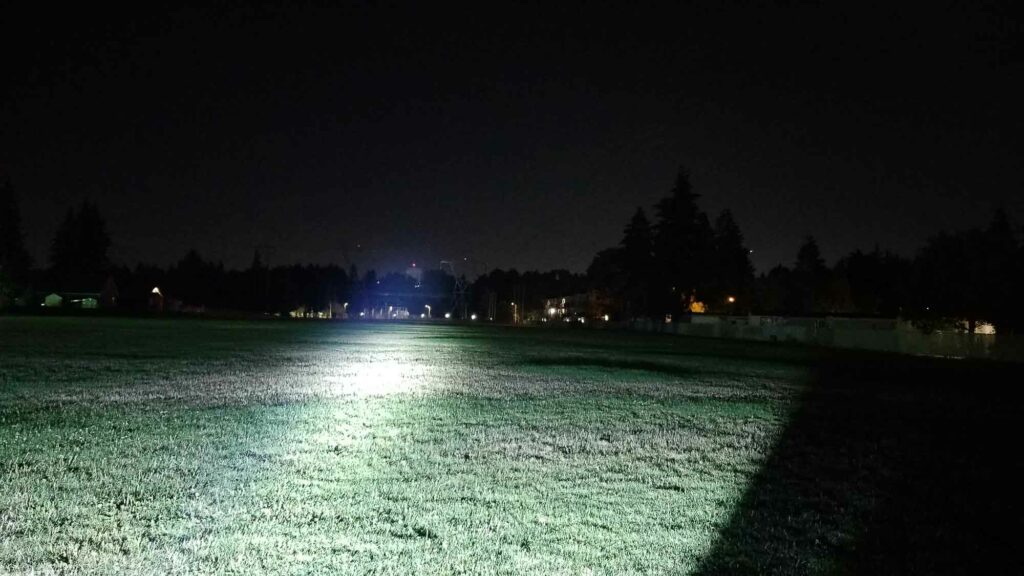
Disclaimer: This flashlight was sent to us for review at no cost by Fenix Lighting US. We have not been paid to review, nor have we been holding back on problems or defects.
Final Verdict
Pros
- Rotary switch is easy to use
- Innovative design
- Solid build quality
- 45W charging and power bank
- Great beam distance and tons of flood
- Great sustained output
Cons
- No mode memory with the rotary switch
- Must run through many lower modes to access a higher mode
- Charger was not included
Explanation on star ratings:
1: Avoid: a match would be a better choice – 2: Poor: significant defect or issues; almost unusable – 3: Average: some defects or issues; but still usable 4: Good: recommended (minor issues) – 5: Great: highly recommended

4.5 stars: ★★★★⋆
While our star rating provides a reliable indicator, we encourage you to read the full review to make an informed decision based on your own needs and preferences.
When I heard Fenix had released a new search and rescue flashlight for their LR series lights, I was a bit taken back, since that lineup is already pretty stacked. Did it really need another high output? Was this a replacement for the LR80R? Fenix must have done their homework with this LR60R, since what they’ve created is a revolutionary flashlight, so revolutionary, it’s been given high honors in the tech community with the Red Dot award for 2023.
First off, for a big flashlight, it has good handling manners, and while I am not a huge fan of rotary switches without buttons, Fenix did a good job designing the LR60R around one. All the things I like about Fenix are here: Great performance, solid build quality, and features that augment functionality. The dual flood/throw lighting modes work great, and give a nice amount of output and beam distance.
There’s a few things I think they could work on though, starting with the limitations imposed by using a rotary switch, namely no mode memory, and if you want Turbo for either lighting mode, you’re switching through all the lower modes to get there (no shortcuts). That’s sort of nitpicking though, since it’s not a design or UI fault, just a limitation of the design.
The worst thing is no charger. I’m fine with 98% of flashlights not including a charger, but for a $400+ flashlight not to have one is unacceptable. Should you run out and drop $400+ on an LR60R? If you really need a top-performing flashlight that has a ton of flood and great beam distance with a throwy beam, and you need something like this, by all means grab one. While the LR80R edges it out in some respects, the LR60R is a great addition to the LR stable. It’s a pretty fantastic high output, professional-use flashlight that can wear a lot of hats. 4.5 stars for the new LR60R.
Buy your Fenix LR60R with a discount
Get 10% off every purchase at Fenix Lighting US, by using our exclusive 1lumen discount code: 1lumen10
1lumen selects and reviews products personally. We may earn affiliate commissions through our links, which help support our testing.